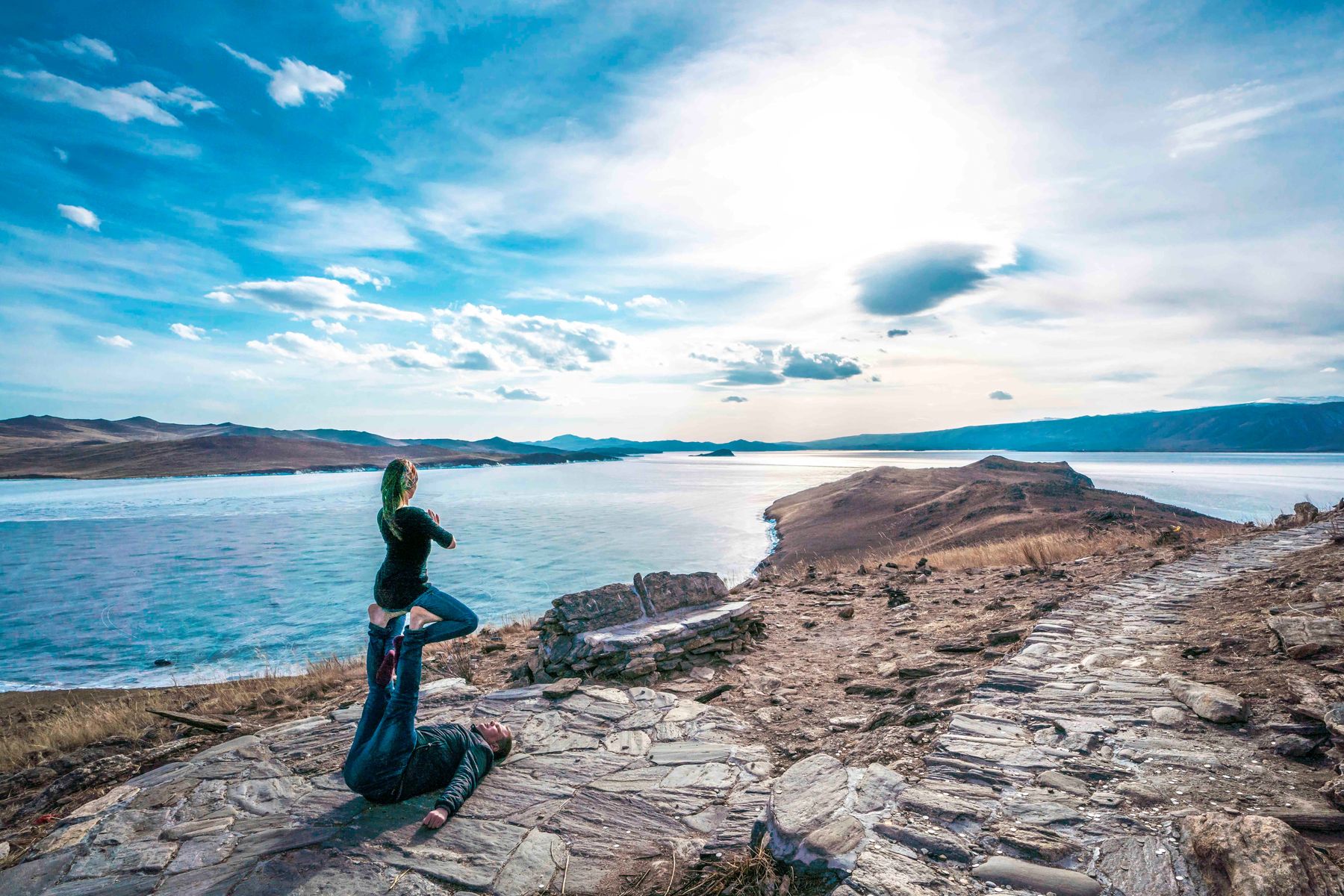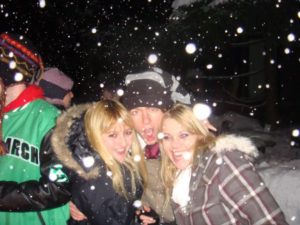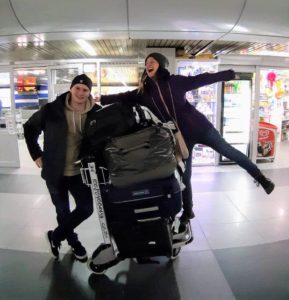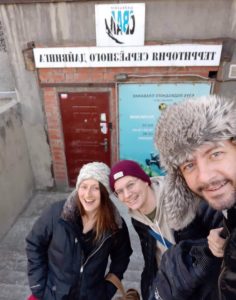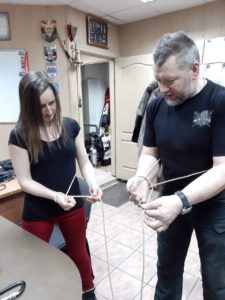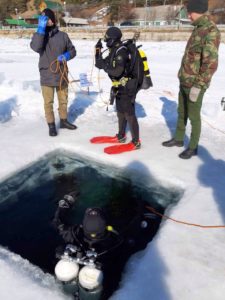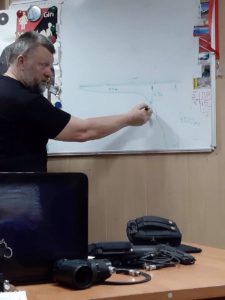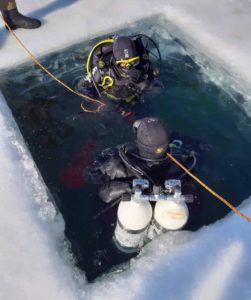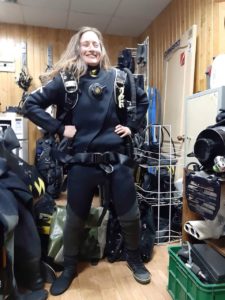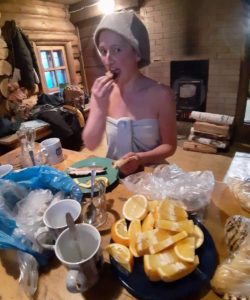Ice Diving in Lake Baikal
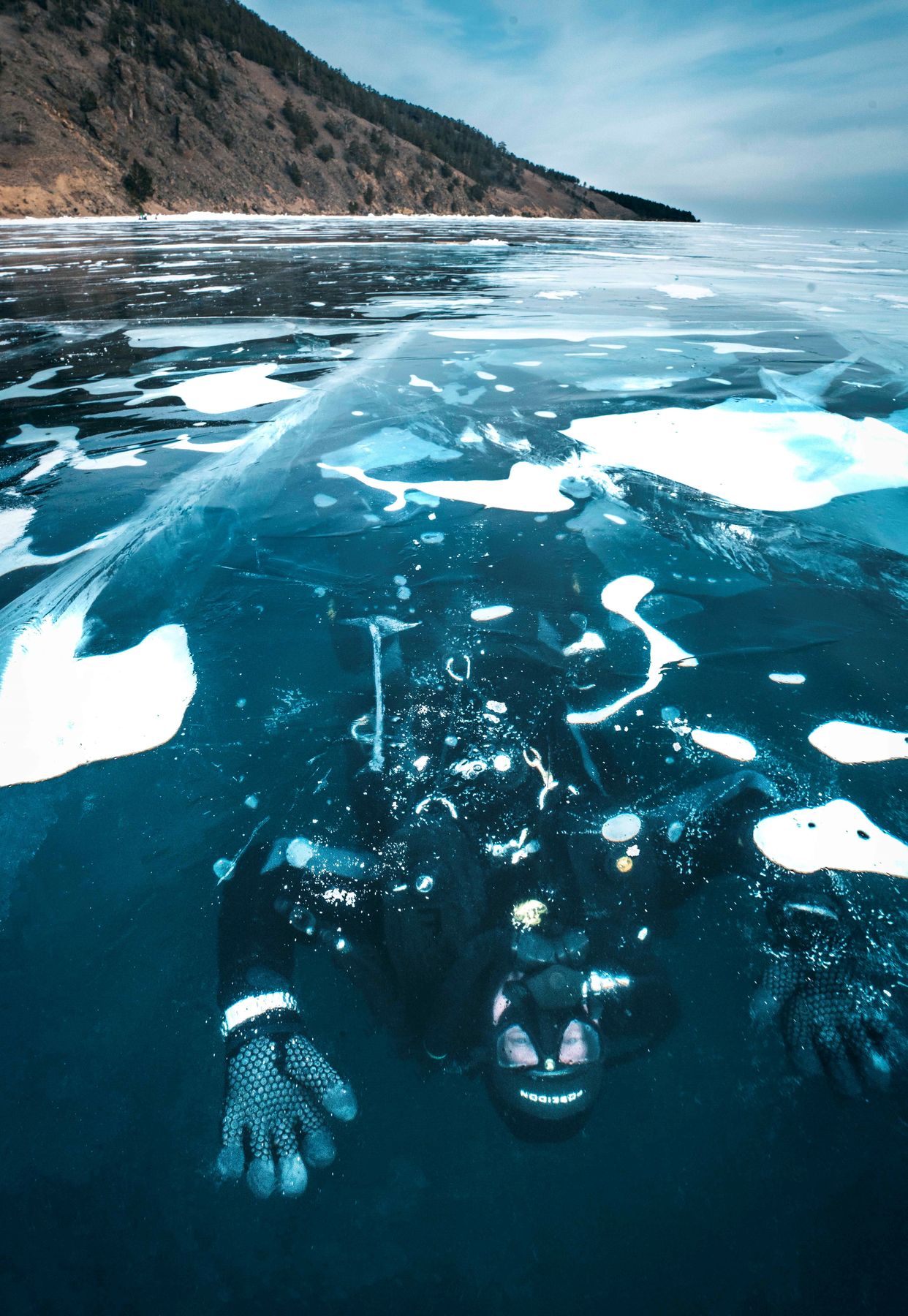
*Diving photos by Alfred Minnaar
Scuba diving is an expensive activity- it requires tons of training, heavy equipment, infrastructure, and more. So you may be asking, “how the hell does somebody like small Sasha, who travels around the world on less than $500 a month, possibly become an ice diver?!”
Here’s the explanation + some information about ice diving in Lake Baikal, Russia:
Personal Story
I have a friend named Alfie. We met in Whistler, Canada, 12 years ago (2007), right after I finished high school and drove across North America on my own. Alfie’s from South Africa but also left home to travel at a young age. We got along straight away because we were both nothing but dirtbags back then :)
We were both dead broke and just lived to have fun- to snowboard, explore the world and seek out adventures. We both left Canada after 2008, but stayed in touch over the years. I kept on traveling and Alfie eventually found himself a job scuba diving in Indonesia.
In 2014, Alfie invited me to Gili Trawangan to do a divemaster internship. He never asked me if I knew anything about scuba diving, he just said, “we need some help in the shop. If you can come to Indonesia and work with us for 3 months, we can certify you all the way up to divemaster for free.”
I was located in Australia at the time and had about $1800 in my bank account, no job and no working visa. I had tried one intro-dive years before but I didn’t know a thing about diving or have an Open Water certificate… So it was pretty hard to refuse Alfie’s offer.
I checked some flights, did the math and bought a one-way ticket to Indonesia, then spent 4 months learning how to dive and helping out in the dive shop.
Learning to Scuba Dive
Every time we splashed into the water, the world above became irrelevant. The underwater world was so different; it seemed peaceful, quiet, yet colorful and alive. We explored underwater landscapes and admired the vivid sea life- fish, coral, turtles, octopuses, cuttlefish, eels, stingrays, nudibranchs, and much more.
We did 2-3 dives almost every day. I felt strong, healthy, and excited, yet absolutely exhausted. After a day of diving, I’d collapse into my bed and dream about the underwater world. Then I’d wake up and my dreams would merge with reality. It was like being in Avatar.
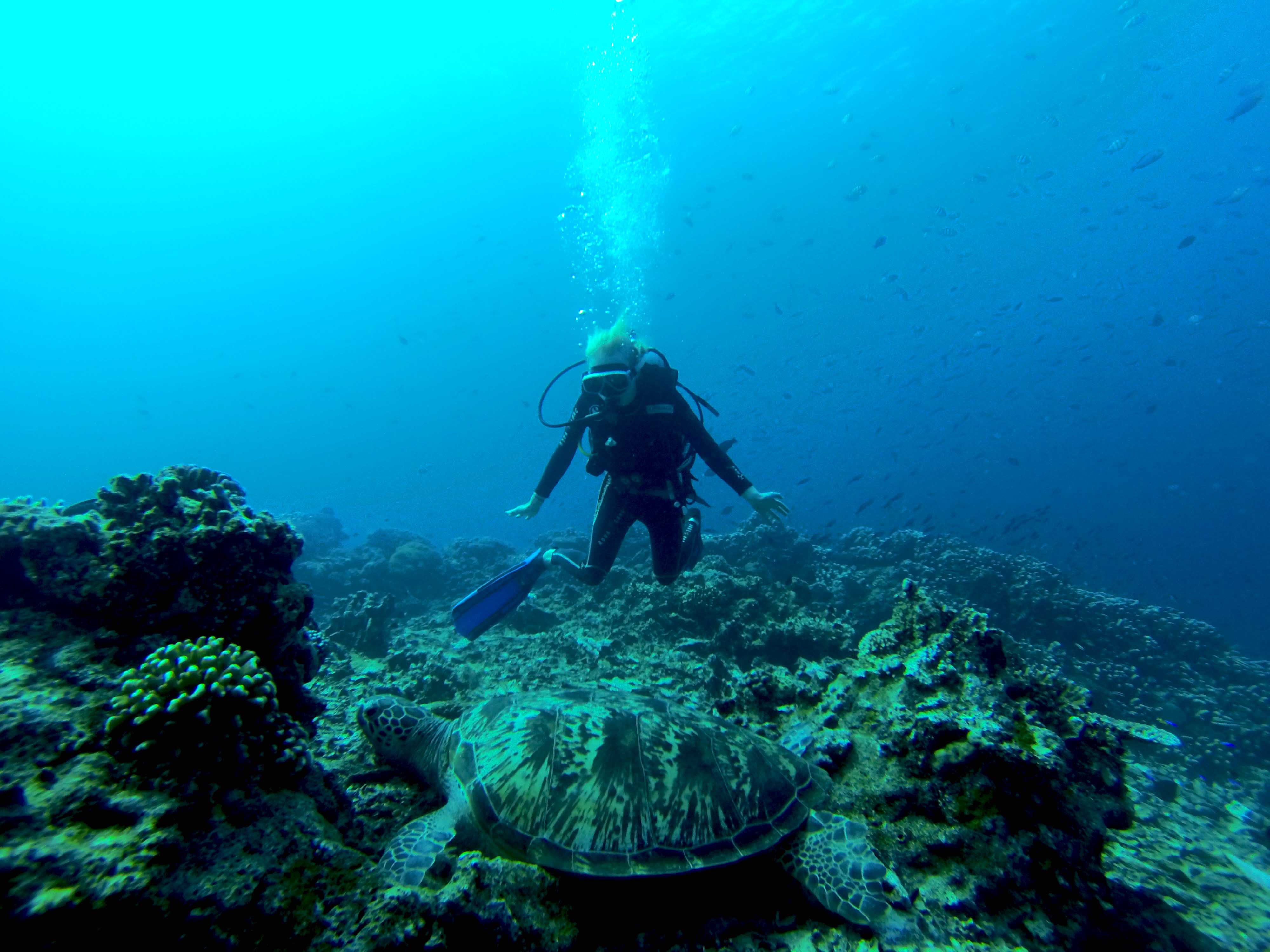
In those 4 months of non-stop diving, I managed to get the following certificates: Open Water Diver, Advanced Diver, Rescue Diver, Divemaster and Nitrox. We did deep dives, drift dives, night dives and even chased after little sharks every once in a while. Between dives, we just had fun with our group of international scuba friends. Back then, none of us, including Alfie, owned a smartphone or shoes.
I left Indonesia when I was down to about $50 in my bank account, bought a flight to Australia and found a cash job in an ice cream shop. I made enough money to buy a flight out of Aus before my tourist visa expired, then lived and traveled in Sri Lanka, Hawaii, Europe, Nicaragua and Russia. I didn’t do much diving in the last 5 years because diving is usually expensive, but I did manage a few fun dives with friends every now and then.
Lake Baikal
I came back to Russia (my country of birth) in August of 2017 and took the railway from Moscow to Siberia. When I saw Lake Baikal, I decided that I wanted to stay there for a little while. I had been traveling for over 10 years at that point, and now I wanted to slow it down, read, write, and watch the seasons change. I also wanted to see Lake Baikal in all of its beauty- to see it freeze and melt, to drink it, breath it, swim in it, and explore the world above and below its frozen winter crust.

I noticed a dive center called New Dimension in a lakeside town called Listvyanka. I did one dive with them in October, then found out about ice diving. I didn’t have enough money for an ice diving course, but this dive center said that I didn’t need one to ice dive with them.
‘Perfect!’ ;)
Alfred Minnaar
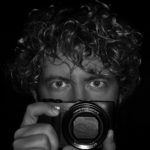
Meanwhile, between 2014 and 2017, Alfie managed to not only buy shoes and a smartphone, but a camera, computer, and underwater housing. He also learned to take great photos and successfully grew his reputation as an underwater photographer using Instagram and some good hook ups on Gili T.
As soon as I found out that you could ice dive in Lake Baikal for relatively cheap, I immediately contacted Alfie and told him to buy a plane ticket to Russia.
His response was, “it looks nice. I will try. I’m low on money… Have to buy a new camera… It’s complicated…”
So he didn’t come in winter of 2018 and I tried my first ice dive on my own, which was an interesting experience. You can read about it here.
The Real Story
After my “discover ice diving” experience, I trolled Alfie a little bit in an attempt to convince him to come to Lake Baikal and take ice diving photos :). I wasn’t expecting much, I just wanted to have some fun diving, take a few cool shots and show Alfie the lake… But Alfie managed to take it up a notch :D Not only did he buy a plane ticket to Russia, but he also found two sponsors for the trip: Poseidon Diving Systems and Delma Watches.
And here’s the funny part that shows that Alfie is still as much of a dirtbag as me :D – Alfie contacted Poseidon and Poseidon contacted their dive connection on Lake Baikal, which was a dive shop called Dive Center Sval. Poseidon asked DC Sval if they could help us out a bit… “maybe just give them some extra gear or some advice about the lake…”
Andrei, the owner and instructor of DC Sval, agreed.
Then Alfie contacted a popular adventure sports videographer named Nicolai Deutsch and pitched him this trip, basically making it sound like Poseidon is sending him on this big one-month ice diving adventure in Russia. Nico liked the idea, sorted out his visa and bought a flight from Germany to Russia.
Then Andrei, from Dive Center Sval, decided to ask Poseidon some very important questions, “are these guys certified ice divers? Are they certified to dive in a dry suit? Have they dived in cold freshwater before?”
The answer was, “no, no, and not really…”
Then Andrei found out that there were three of us: Alfie, Nico, and me (photographer, videographer, and dive “model?” :D ).
“Alright,” said Andrei, “that means not just gear and advice, that means a full ice diving course. For three people…”
That was clearly a lot more work for Andrei, but he was willing to do that for Poseidon because he works with this company and has a lot of respect for their gear.
However, soon after, Andrei also realized that not only did he have to give all three of us a free ice diving course, but he would also have to drive us around to different dive sites, dig new ice holes for us and participate in the making of these underwater photos and film clips.
Andrei’s wife, Olga, explained that Andrei enjoys training people to see progress and results, but what he absolutely detests is publicizing his own face.
…And soon after our arrival, Andrei found out that not only did he have to give us gear, tanks, ice diving courses, drive us around, make new ice holes, and take care of us under ice, but he also needed to be the “star” of all of our film clips and photos! AND his face might end up on the cover of a magazine! :D
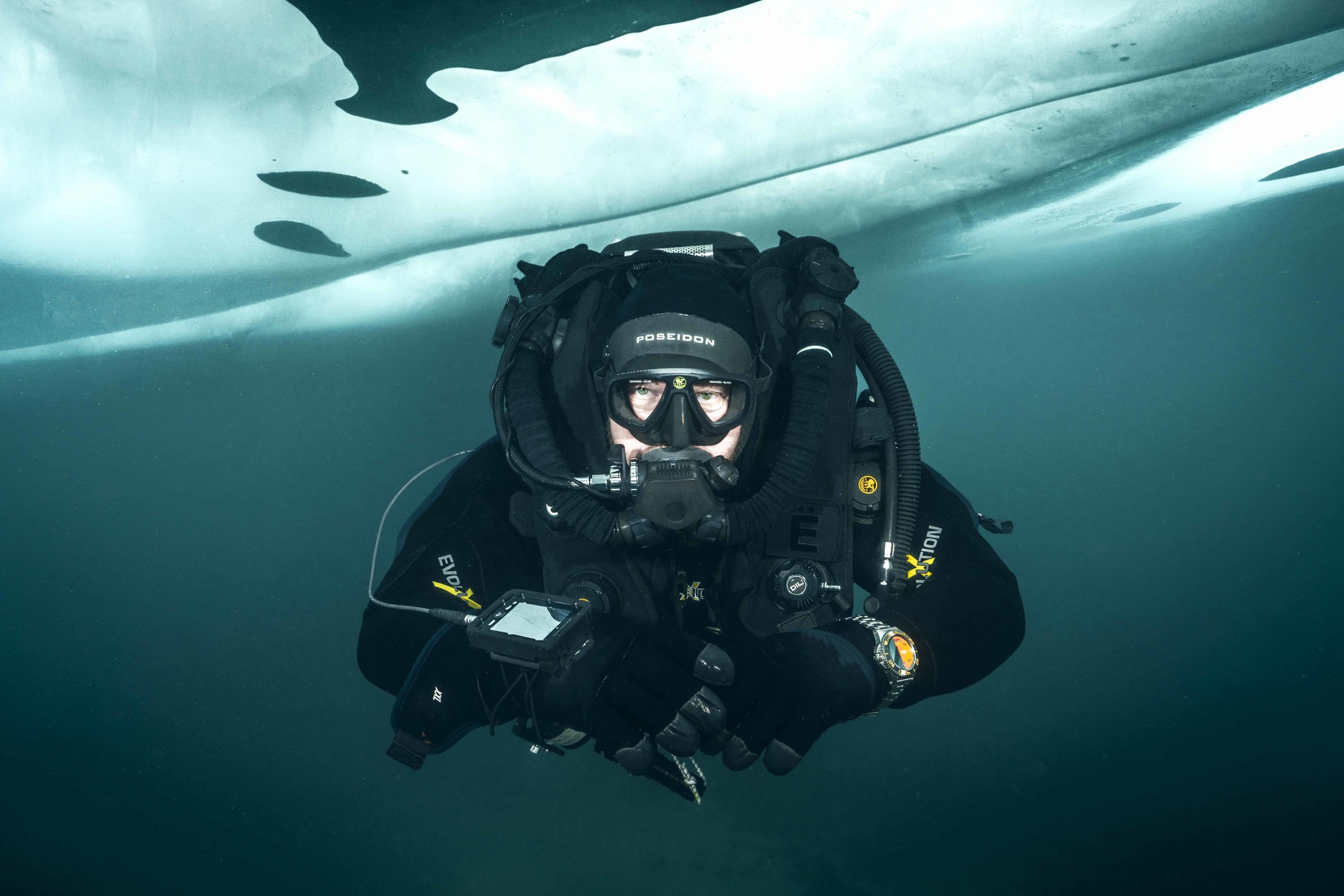
Ice Diving Course
Once we started the course with Andrei at Dive Center Sval, I realized how dangerous it was to ice dive without proper training.
Andrei took us through all the vital elements and procedures of ice diving: making a “mine” in the ice, using safety line signals both above and below the ice, learning how to use a dry suit, controlling the equipment, organizing the dive, rescue diving procedures under ice, and much more.
Andrei warned us about gear malfunctioning in the cold, but I didn’t think that this would happen very often. It turned out that I was wrong. One of our regulators froze up and free-flowed almost every dive. This was probably because the three of us always took too long to get from the warm hut (or car) to the “warm” (1-degree) water. Remember, freshwater will not be below freezing, so it is warm compared to winter air temperatures in Siberia. Your equipment freezes when you spend too much time outside in the cold air, so your job is to get from warm air to “warm” water as quickly and efficiently as possible, of course, while being organized and following safety procedures.
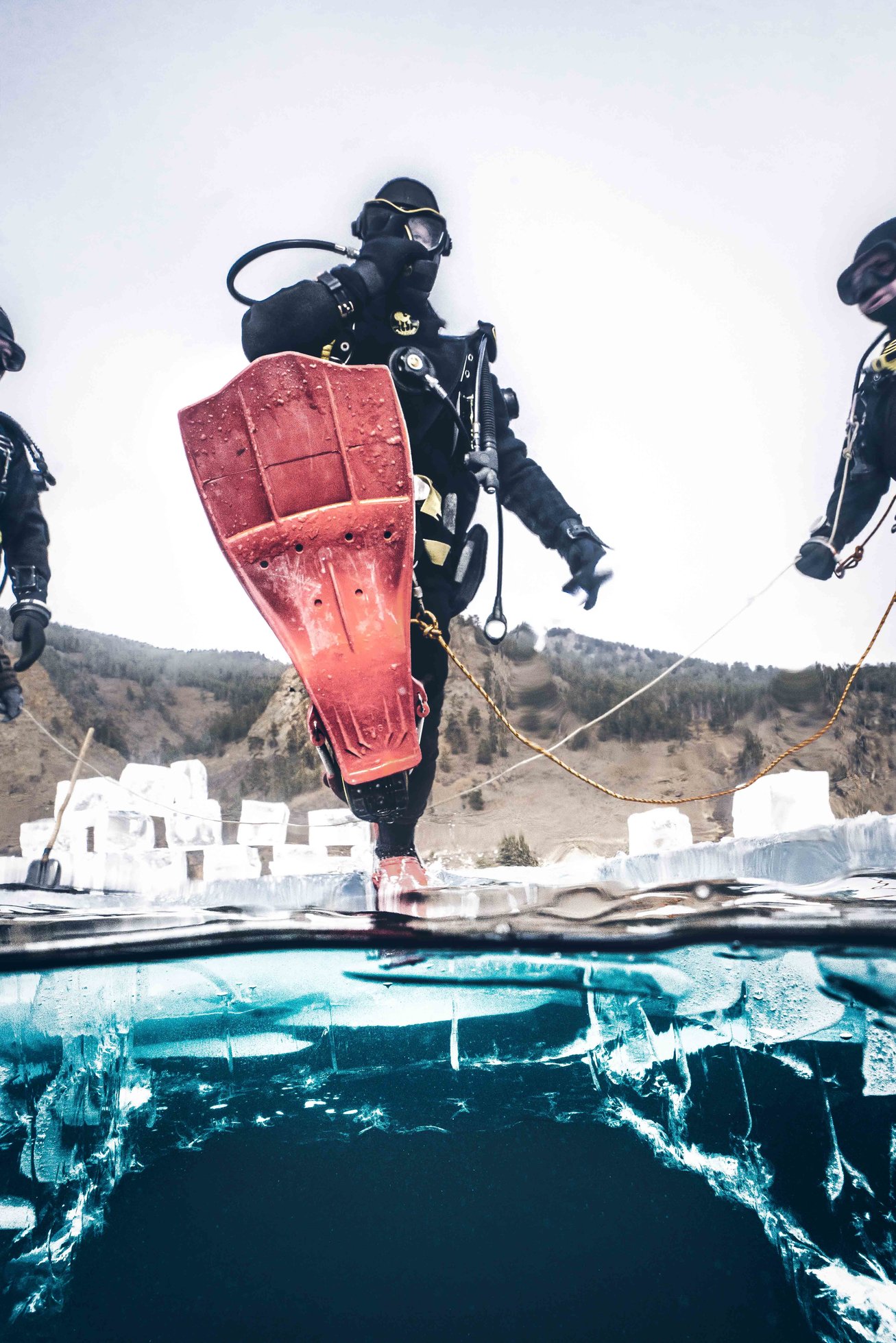
Dry Suit Diving
The greatest challenge for me was the dry suit. Whenever I had to put it on or take it off, I felt like Jim Carrey in the movie, Ace Ventura. You know, that scene where he came out of a rhino.
By the end of the week, I learned that I had to dance to reggaeton to get the suit on without assistance.
Diving in a dry suit is much more challenging than diving in a wetsuit. There’s a layer of air between your skin, the suit, and the water, so when you descend, the air pressure decreases and the dry suit squeezes onto your skin. If you don’t add air to the dry suit, it will compress your body like a vacuum package. When you ascend, the air in your dry suit expands. The higher you go, the more it expands and the faster it shoots you up to the surface. Going up too fast is dangerous because the air in your lungs also expands as you ascend. In ice diving, there is an added danger of hitting your head against the layer of ice on the surface.
You have to release air from your suit to stop yourself from ascending uncontrollably. Air can get trapped at the feet, where there is no release valve. If this happens, you have to change your body position to move the air bubble up to your shoulder. You must learn to control that air bubble!
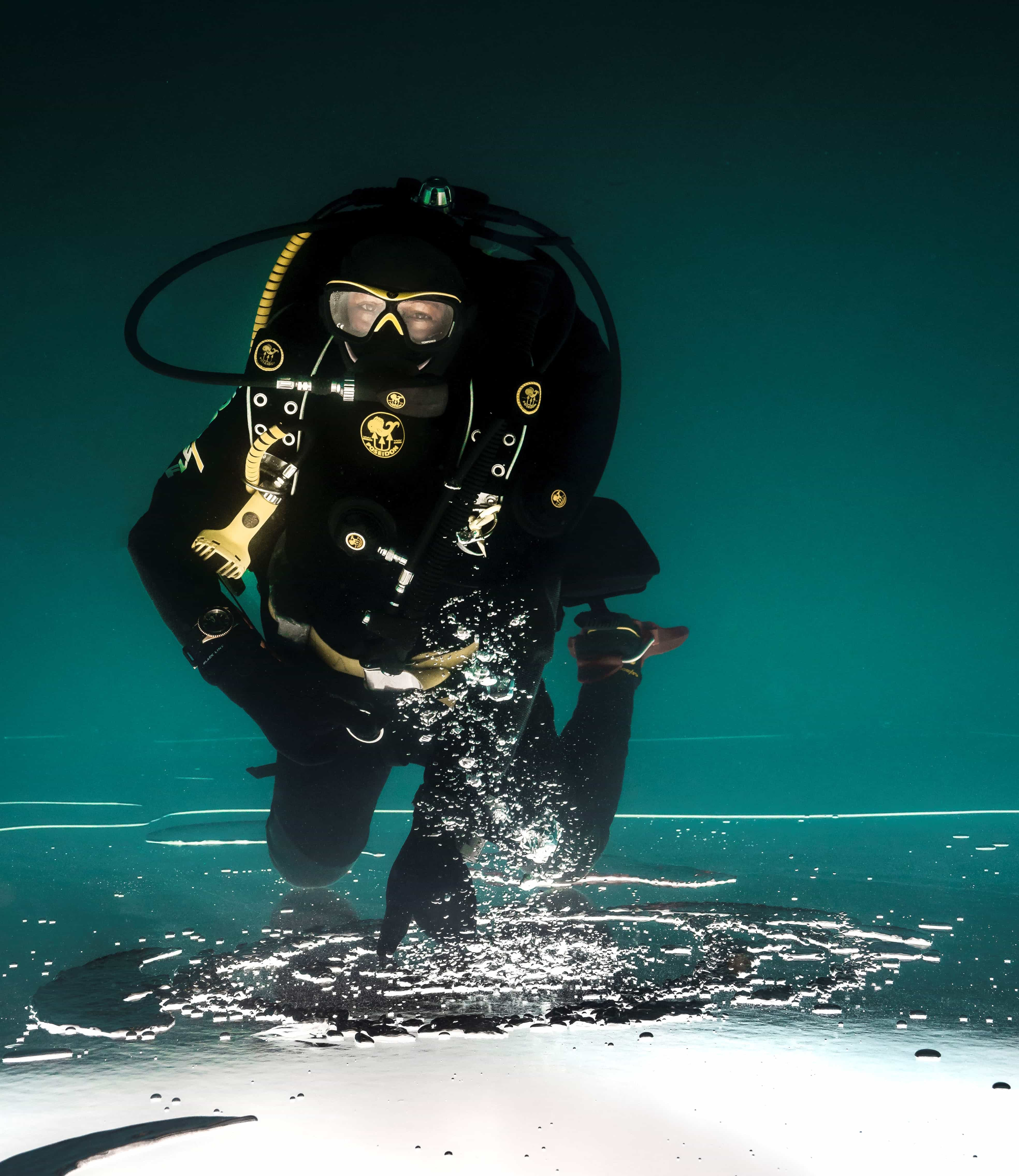
Our first day of diving was not under ice, but just at the edge of the frozen lake, where Lake Baikal meets the Angara River. I felt a bit shaky at first, since this was my first dive in one year, and diving Lake Baikal is so different to diving in the tropics. Within the first 10 minutes of diving, air got trapped at my feet and started pushing me upside down. I changed my body position as Andrei instructed, but got nervous and somehow choked on water, then shot up to the surface. I started doubting my own diving skills then, thinking, ‘maybe I am not an experienced enough diver to pull off this ice diving shoot…’
Andrei met me on the surface, calmed me down, took me back underwater and showed me how to gain control of my equipment. We did buoyancy exercises and learned how to control that air bubble. Once Alfie and I felt comfortable, we went for a short swim around the ice.
I am so grateful to have had Andrei as our instructor :)
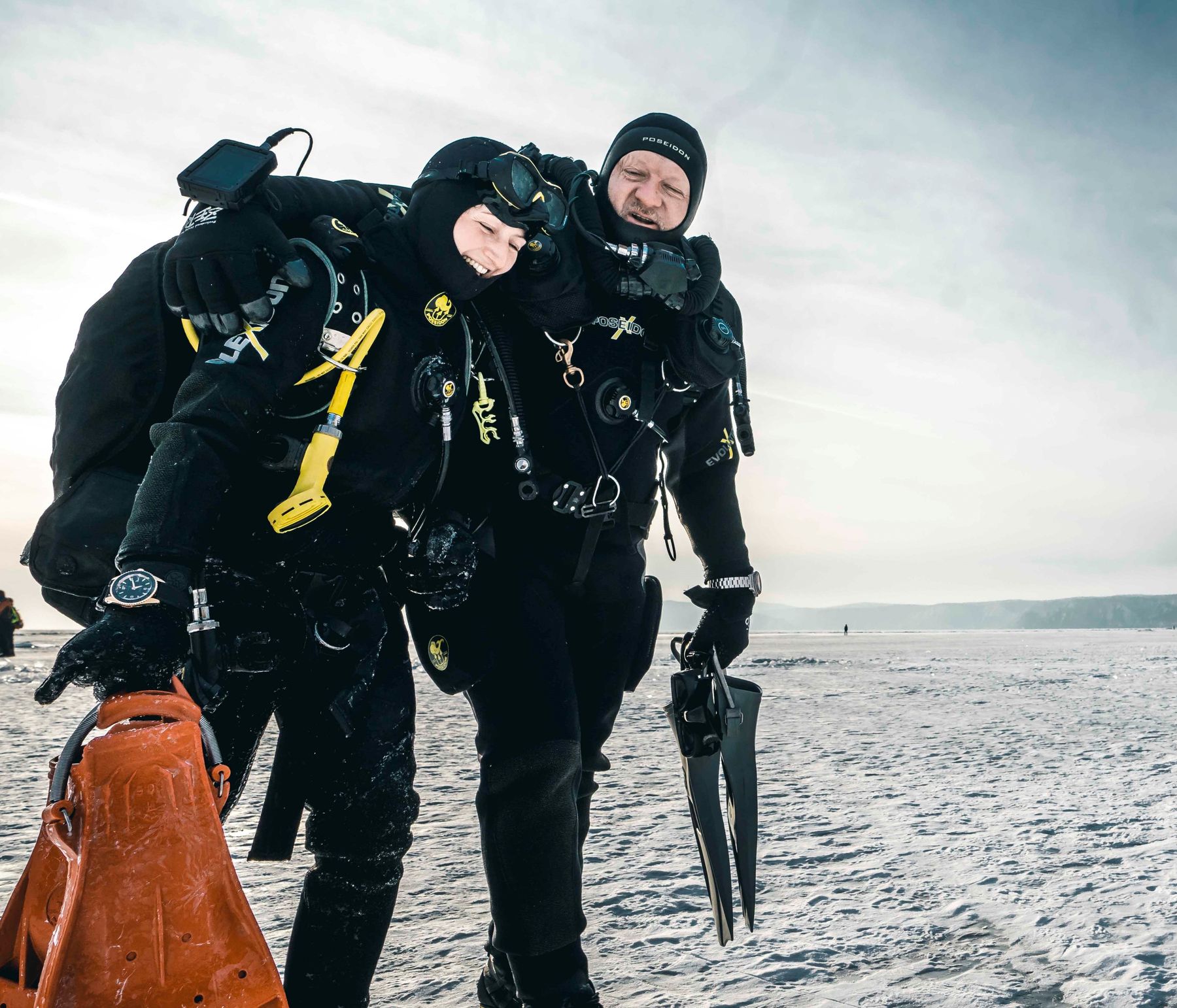
Diving Under Ice
The next day, we jumped into our first mine. I felt more comfortable with the dry suit this time, but I ran into new trouble- claustrophobia.
Lake Baikal is the deepest lake in the world (1.6 km deep) but its depth does not change gradually, so when you dive Baikal, you either dive extra shallow (2-3 meters deep) or you dive a wall that drops down to over 100 meters beneath the surface.
Our first official ice dive with DC Sval was in shallow water topped by 1-meter-thick ice. I knew I was in safe hands with Andrei and his divers, but it was a psychological challenge to calm my mind while floating in the 2-meter space between thick ice and the ground below. The water was crystal clear and the ice was enchanting, but at one point an overwhelming fear came over me-
‘the space between the ground and the ice is so tight! I can’t maneuver easily! I lost sight of our exit! There’s a meter of ice above my head!’
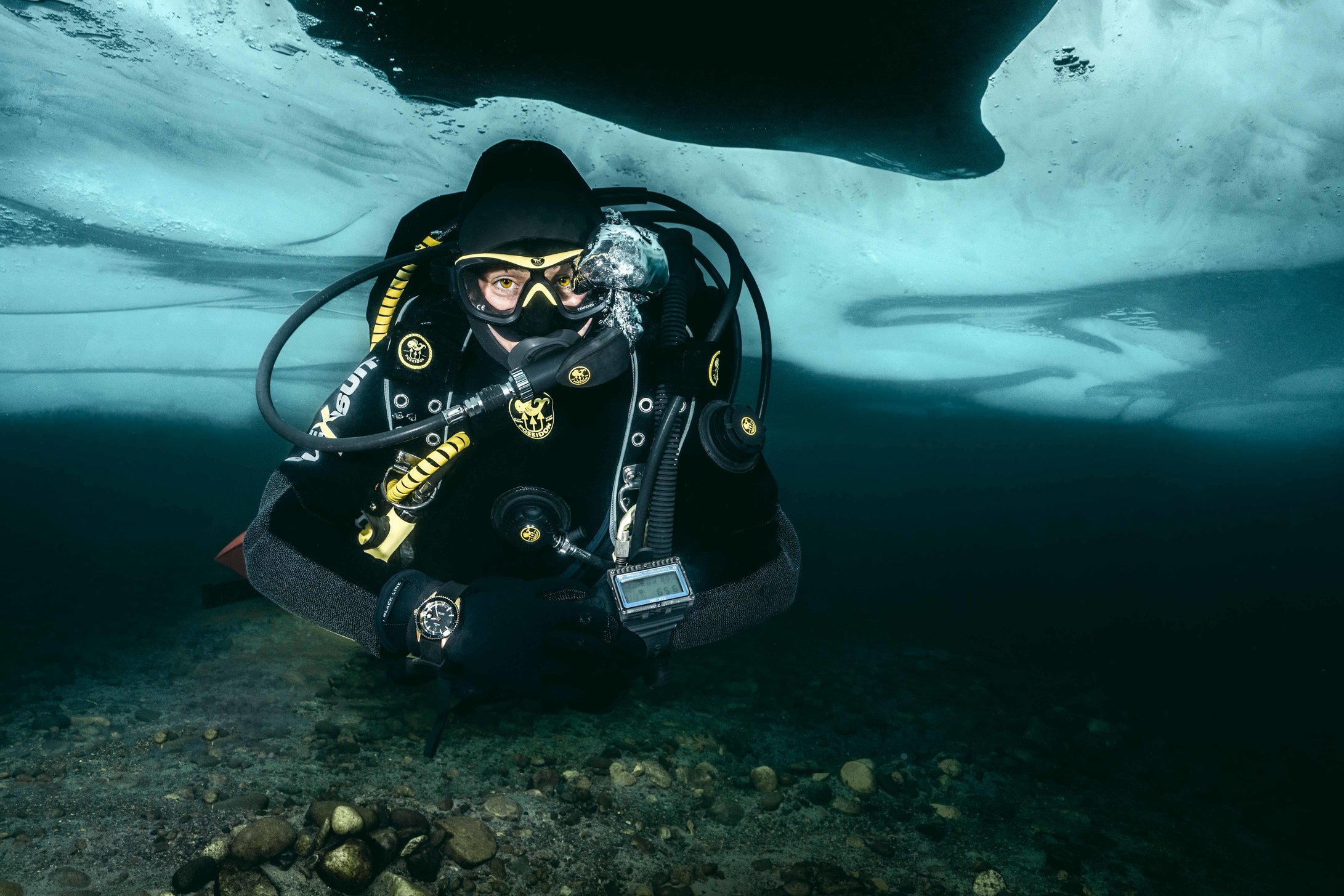
I knew that the worst thing that a diver can do is panic, so I looked down at the ground, breathed in steadily and calmed down my mind.
‘It’s all psychological. Feel the rope, move slowly, don’t panic. Breathe. Take a look at the exit. Breathe. Admire the ice and the beauty of Lake Baikal- that’s what you’re really here for, isn’t it?’
I calmed down and kept on diving. After the dive, my dive-buddy Dima said:
“when you dive in the tropics, you dive to have a look at the underwater world- fish, turtles, sea-life, and beautiful reefs, but when you dive Lake Baikal, you dive to look inside yourself.”
I kept this in mind when we dove the 120 meter drop the next day.
Diving Lake Baikal
The challenge of diving Lake Baikal comes from the conditions- freshwater, cold temperatures, and steep vertical drops. I’ve dived many vertical walls in warm saltwater and after over 100 dives in Indonesia, I never thought I would have a problem with buoyancy, but here in Lake Baikal, I felt my body plummeting down the side of the 120-meter wall. This time, I kept Dima’s words in mind, “when you dive Lake Baikal, you dive to look inside yourself.”
‘Be calm, be rational, be strong. Control your body- use your lungs. Control your mind- never panic. Control your equipment. Remember your training.’
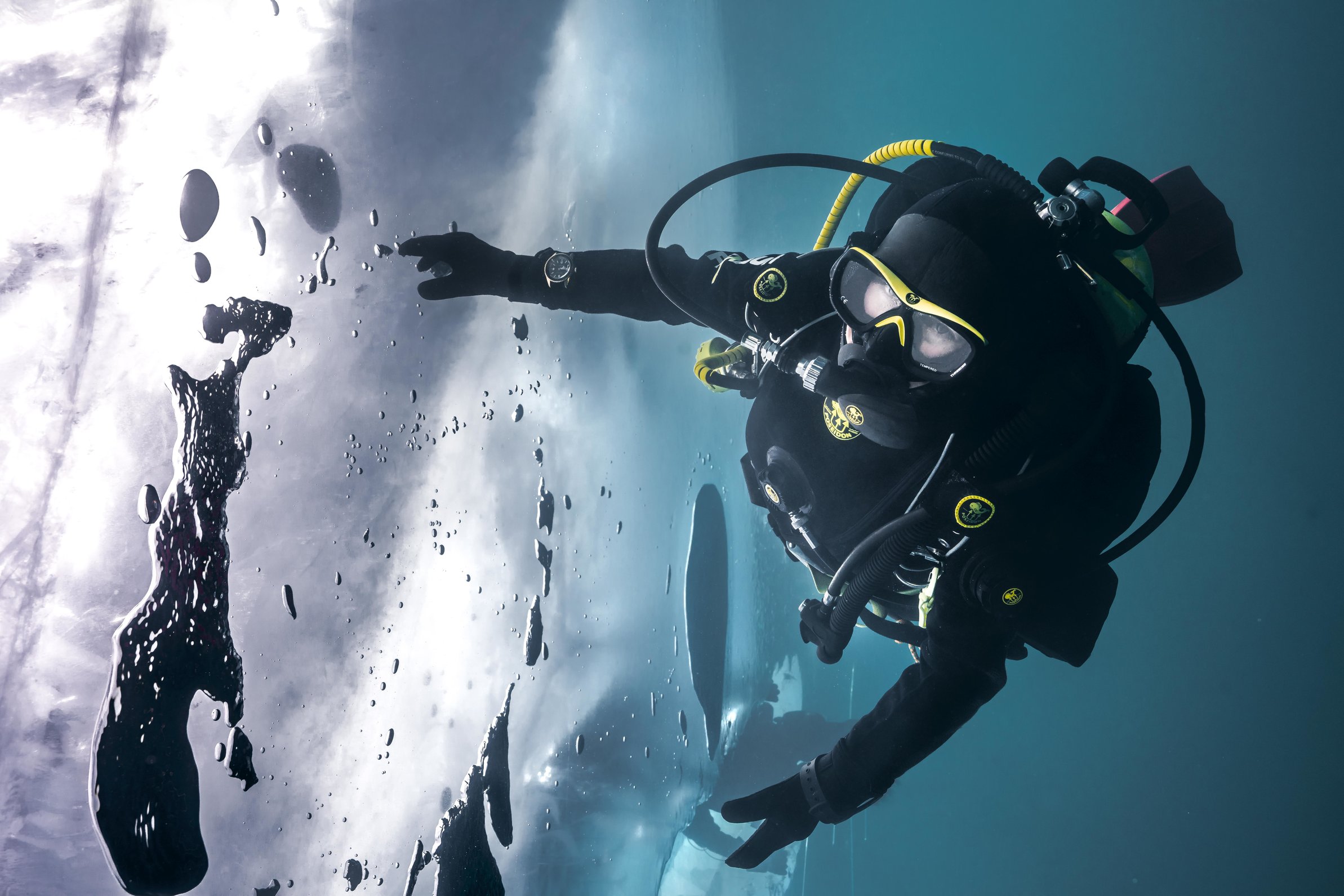
Andrei explained that people lose half their brain when they’re underwater. They panic and lose the ability to make easy, simple decisions that would save their lives. This is hard for people understand when they’re sitting on their couch, but underwater, everything is different.
So to be a good diver you have to learn to think underwater. Your brain has to function the same way below the ice as it does above the ice- and this takes tons of practice and training.
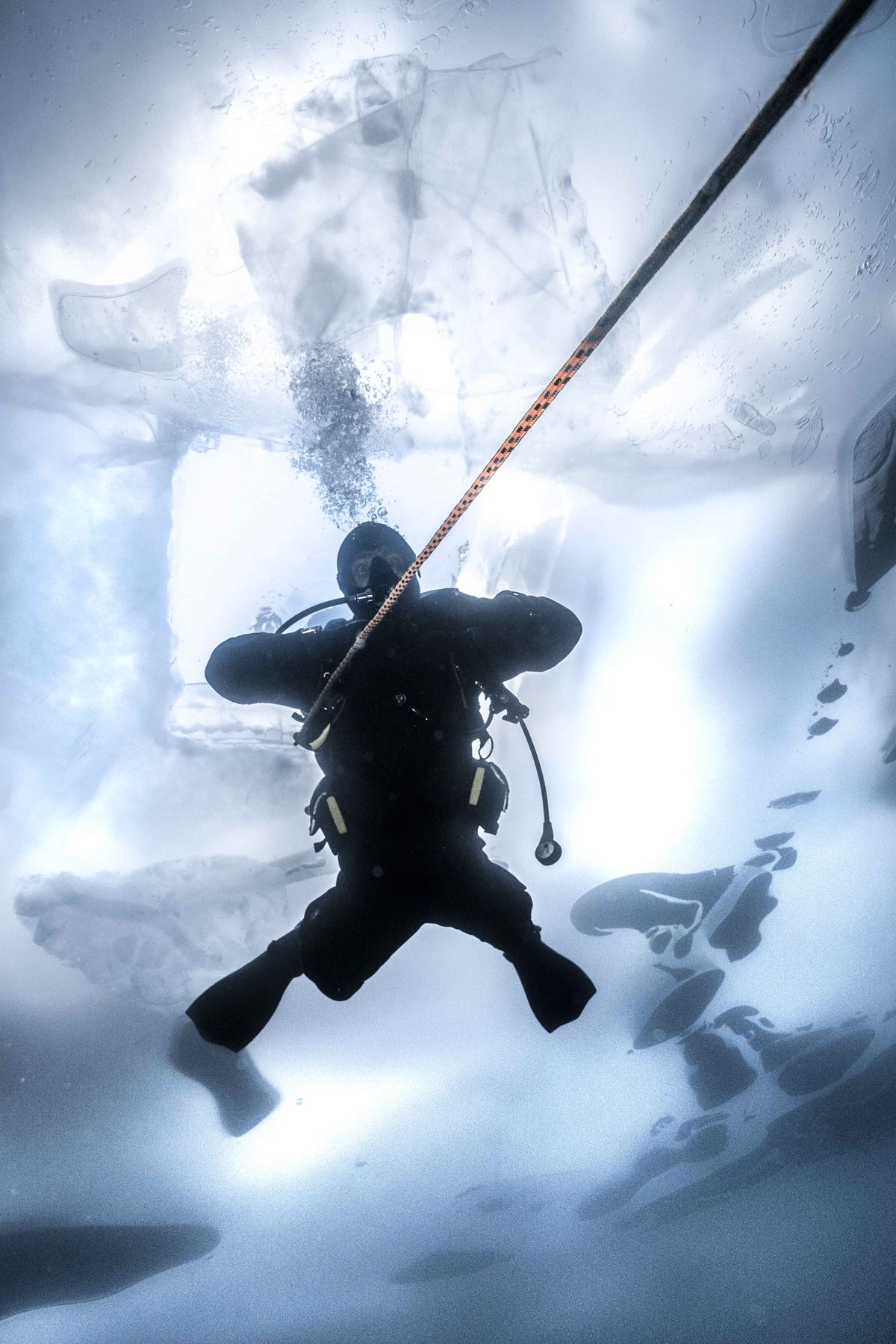
I got it together that time and had a great dive with Dima down the side of the wall to a small cave. I was surprised at how much light there was coming through the thick, snow-covered ice in Listvyanka.
Alfie and Nico tried out their camera equipment for the first time under ice.
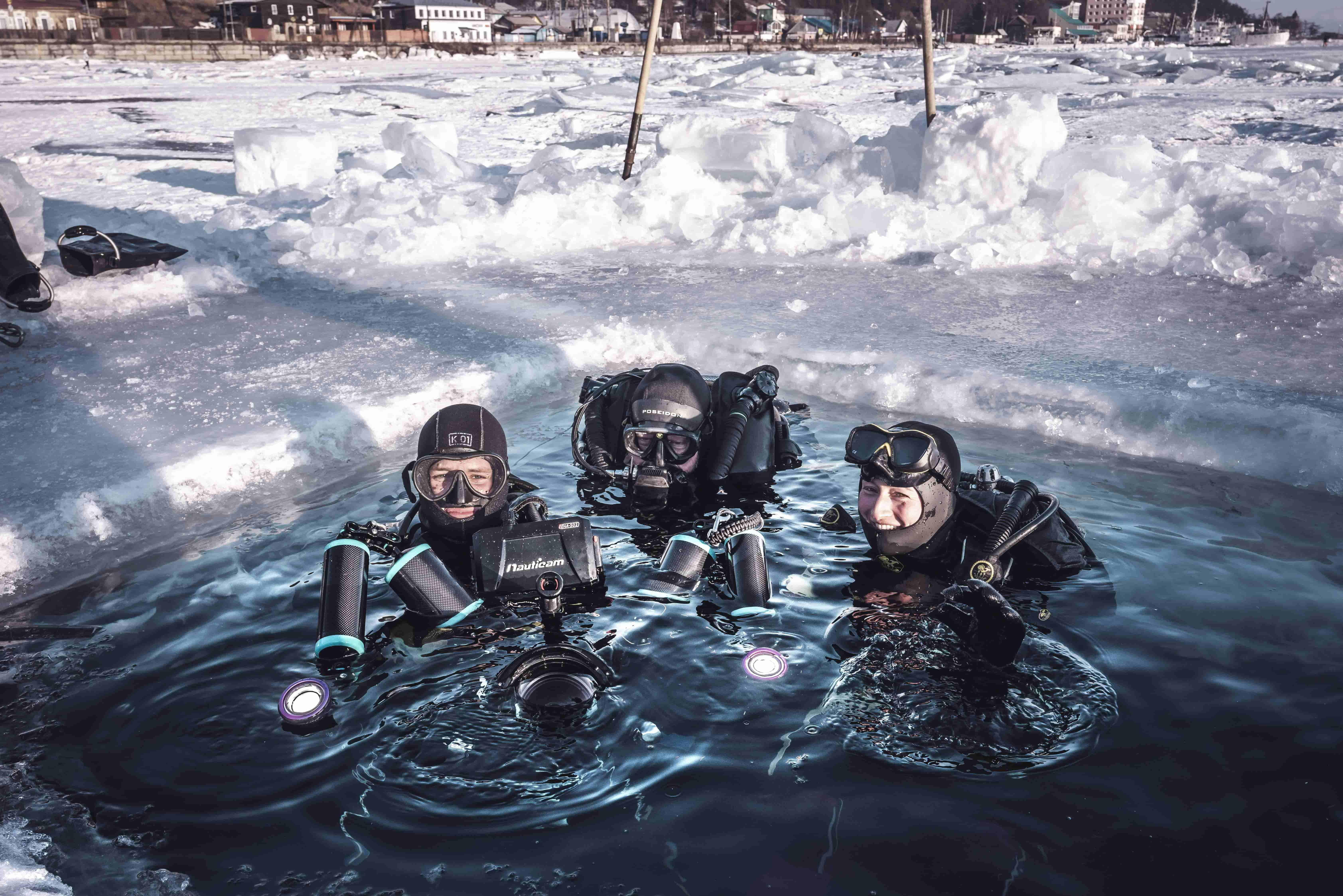
Apparently, Alfie couldn’t hold his buoyancy either and was bobbing up and down like an Open Water student, which is crazy because he’s had thousands of dives!
I thought ice diving and Siberian winter was going to kill him actually :) Coming from tropical Indonesia, Alfie was absolutely exhausted after every cold dive; he slept a lot and was on the verge of getting sick. Nico, on the other hand, came from Germany and seemed to handle everything quite well- from the dry suit, to his buoyancy control, to the cold.
So we didn’t get many underwater photos from that first dive, but we got some great video footage and some pretty cool “above the ice” photos and videos.
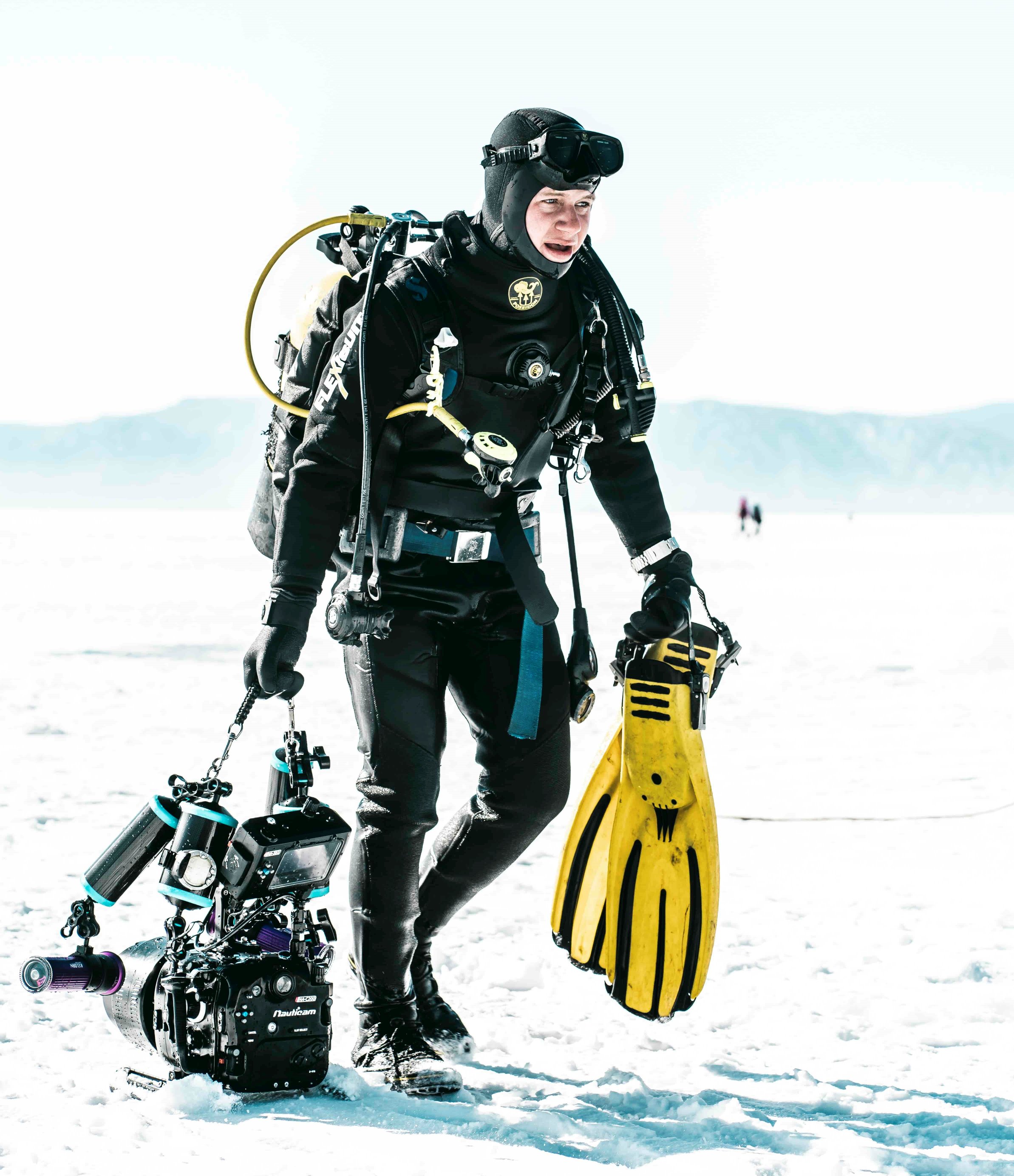
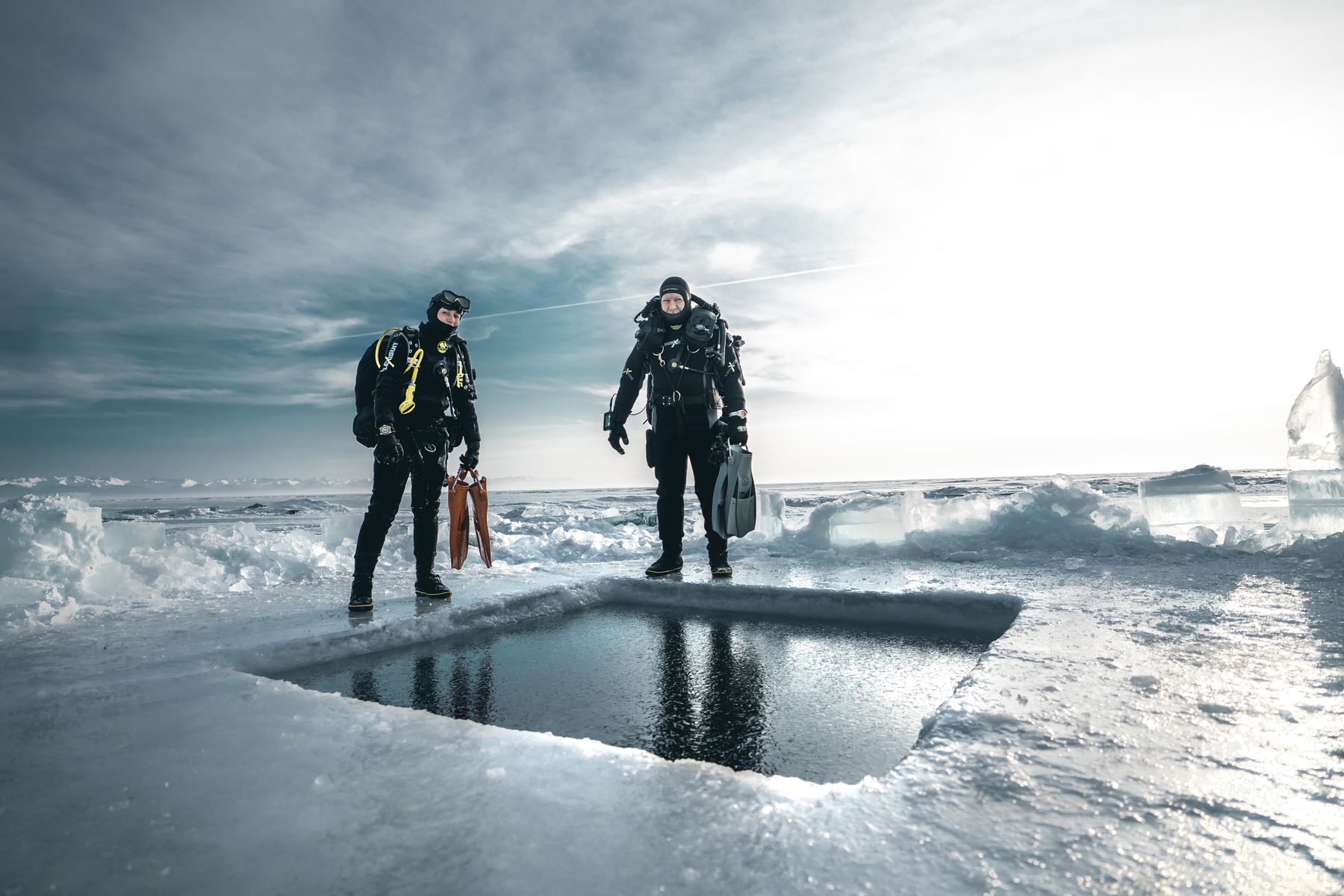
Getting these shots was actually very exhausting. Andrei and I had to walk around with steel tanks on our backs for about 30 minutes, right after an ice dive. Our dry suits froze in the cold air and we tried not to slip on ice as we walked around the mine feeling like robots.
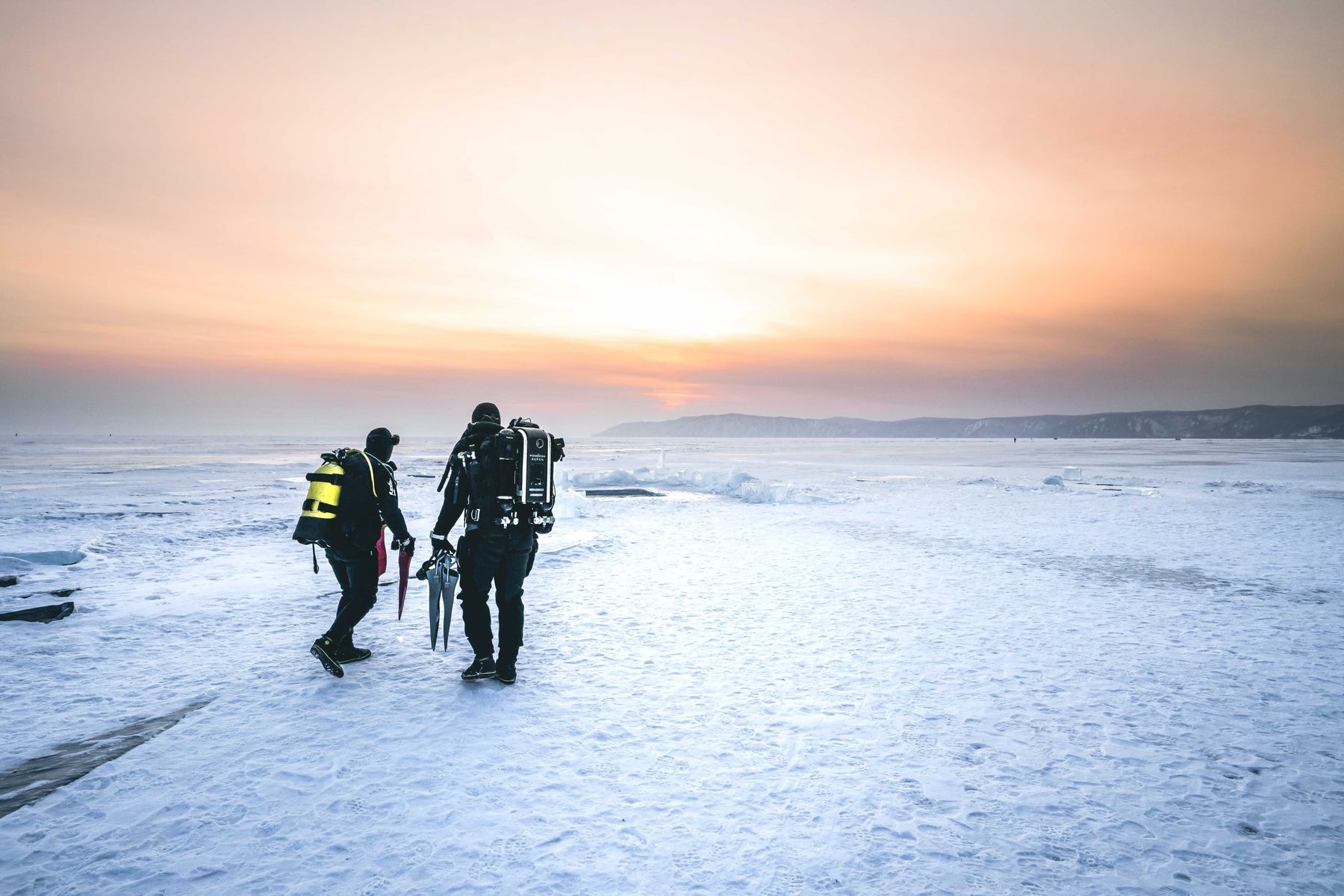
Diving Bolshiye Koty
Andrei arranged for us to dive in two freshly made mines in a town called Bolshiye Koty, about 20km away from Listvyanka. We paid about $100 to have each new mine made for us (because making a mine is a huge amount of work) and another $100 for a guide to safely take us over the ice in a vehicle. There is no road going to Bolshiye Koty so the only way to get there is via ice in the winter, boat in the summer, or the Great Baikal Trail.
The drive can be dangerous even over 2-meter-thick ice because you can run into huge ice cracks and sections of ice that become unstable from methane bubbles. And as you can imagine, stopping a car on ice is a bit slipperier than stopping one on land. Andrei said that he had found many dead bodies in Lake Baikal, so he was extra cautious during this drive.
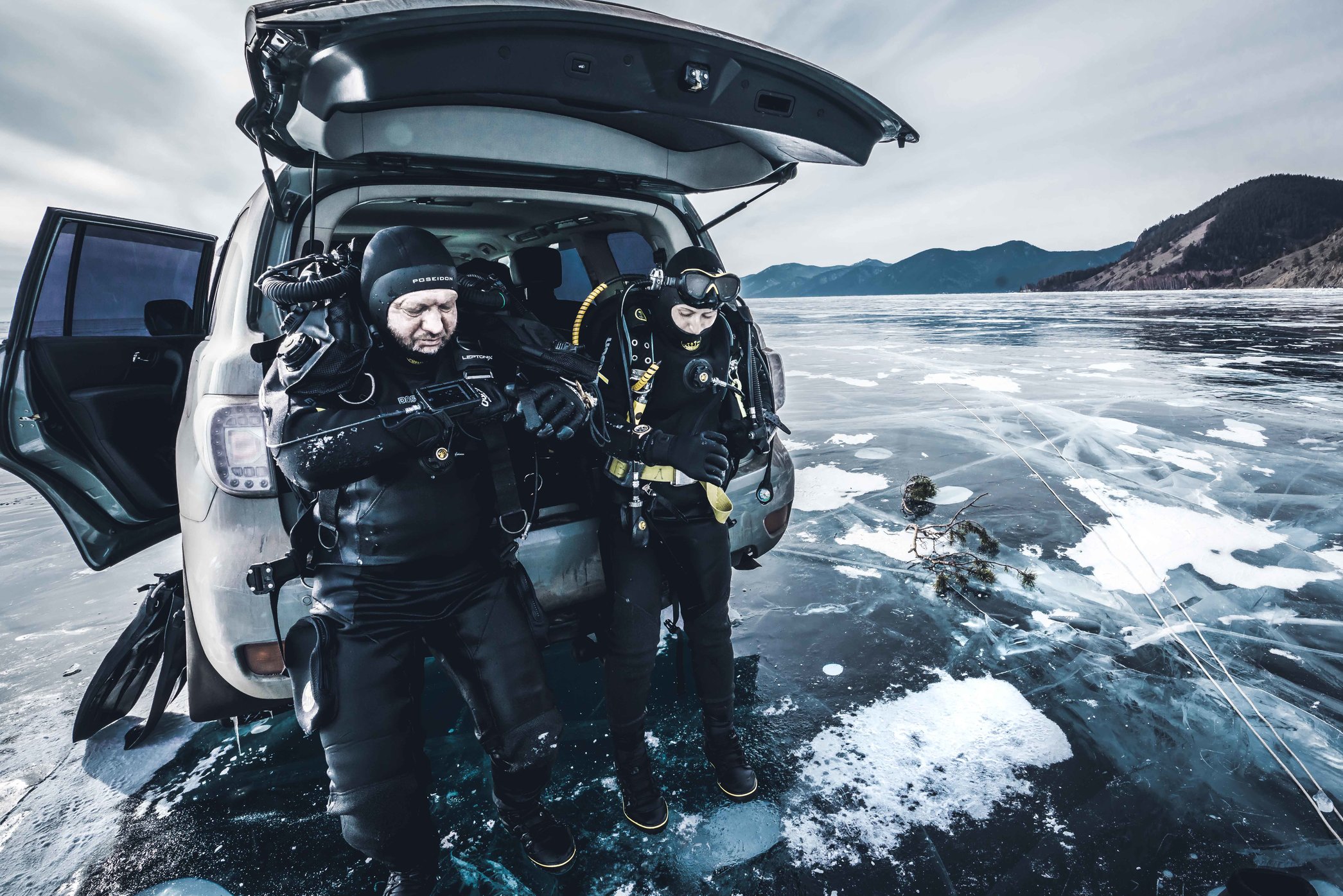
The Bolshiye Koty dive sites were spectacular. The first mine was next to huge, crystal clear blocks of ice, sections of clear, cracked ice, and mountains on the shoreline.
We jumped in the mine and admired the ice cracks from the underside, then dropped down to a staggering canyon. On top of the canyon was a cross that was put there by Andrei himself, in memory of his best friend.
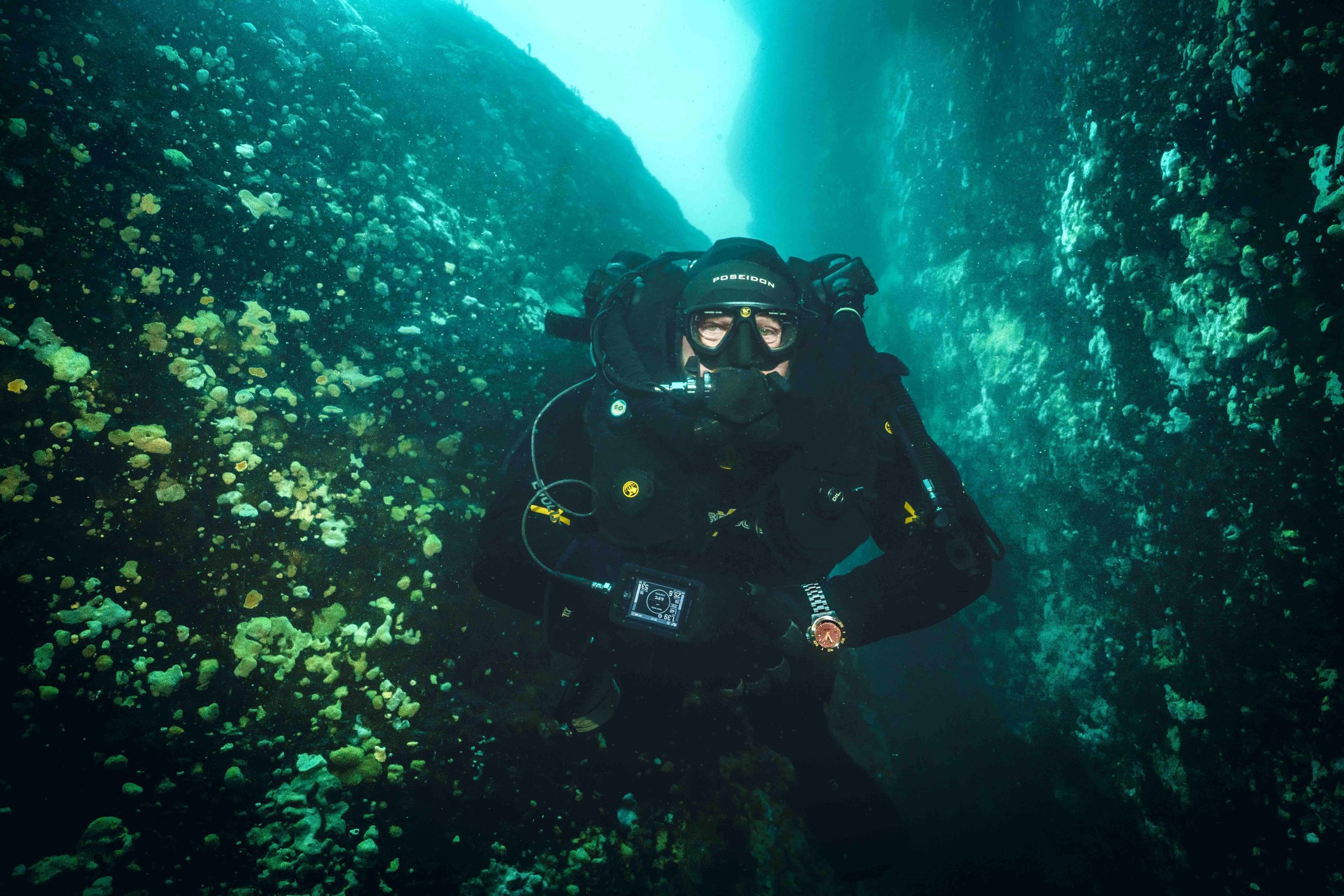
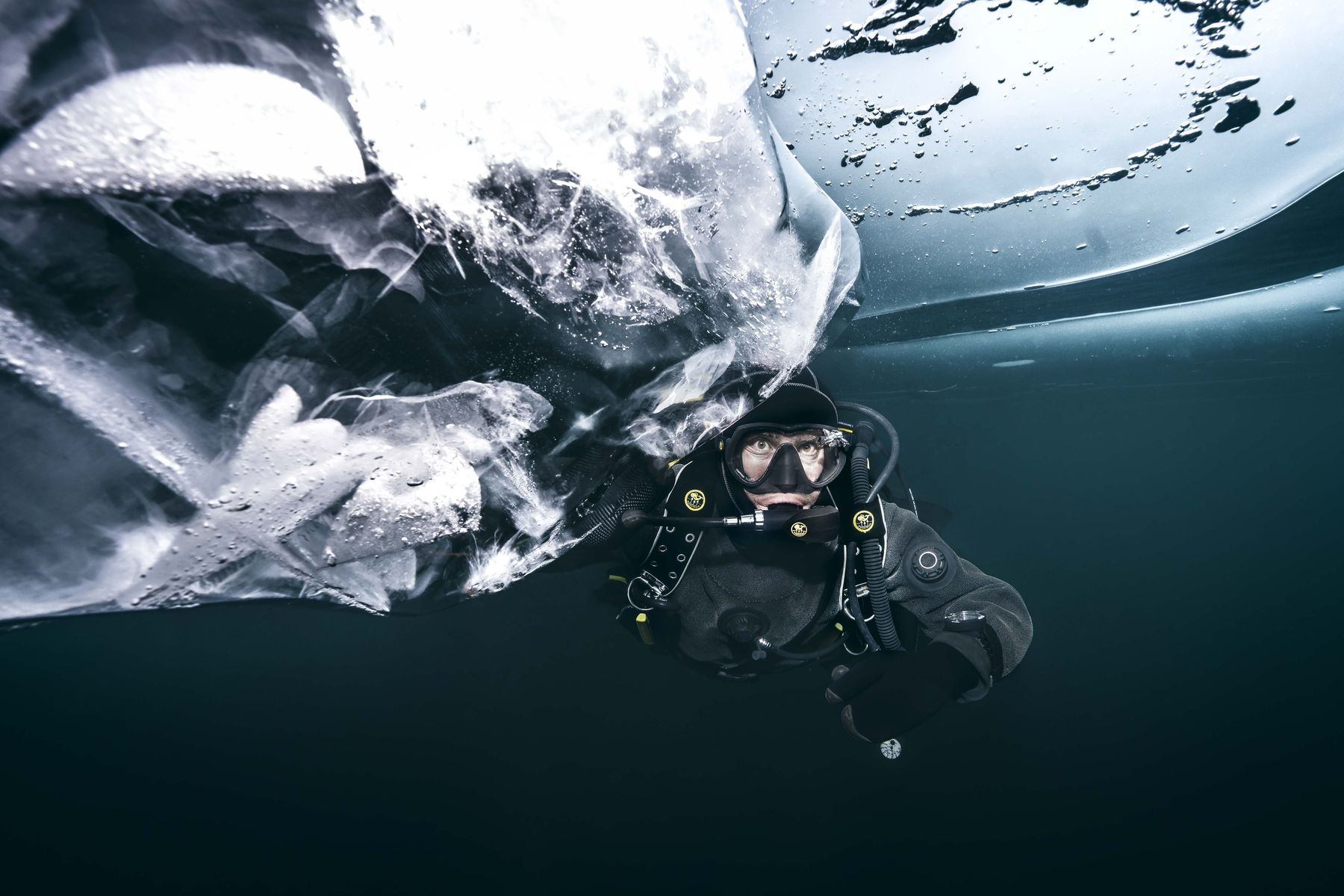
Each dive was usually only about 30-minutes long and we only did one dive per day. Doing more than one dive wasn’t really an option since our equipment would freeze in the cold air between dives. The air temperature was “pretty warm” while we were there (around -12°C) but that was still cold enough to freeze our equipment in a matter of minutes.
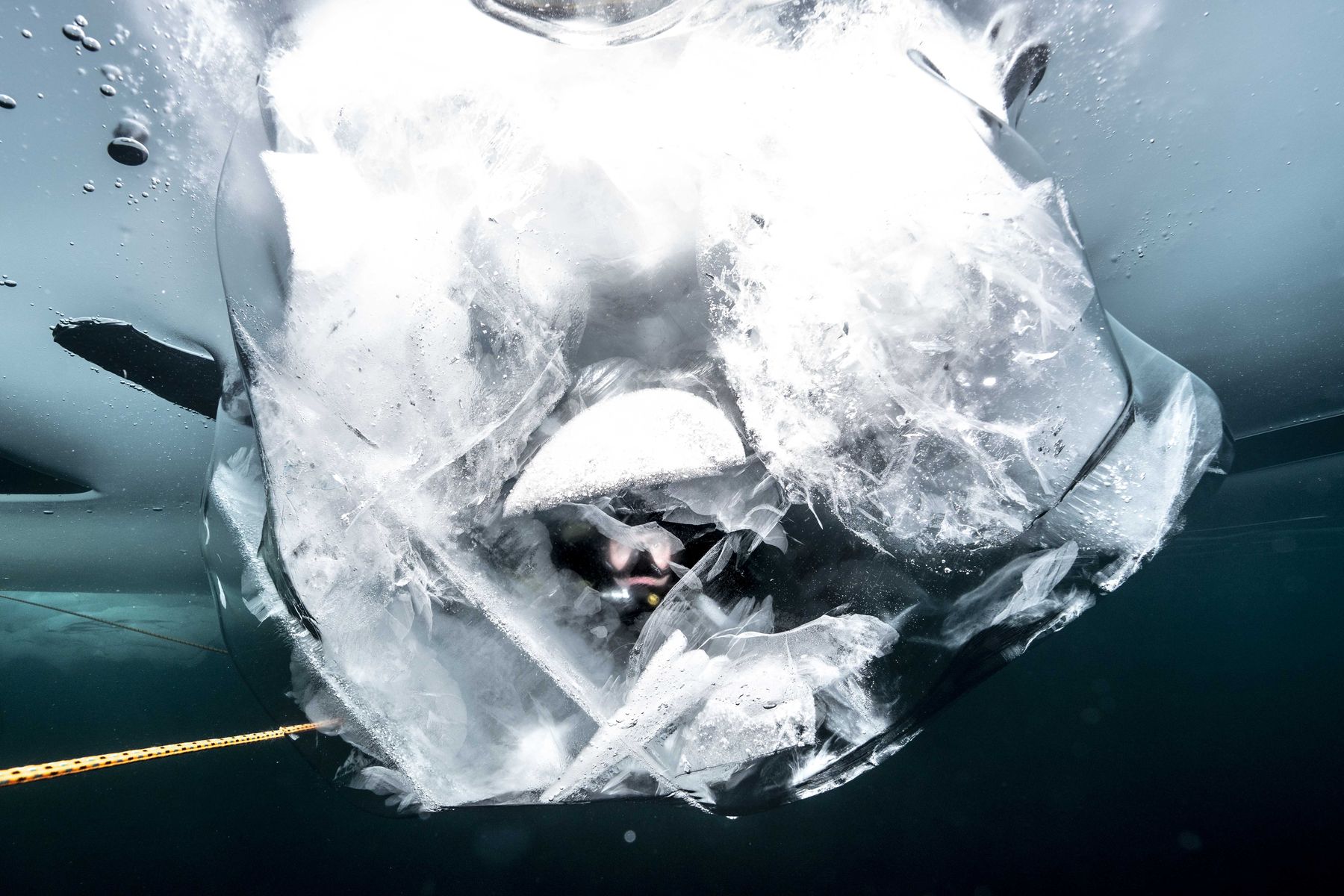
Usually mines are about 2 x 2 meters, but we asked to make one 3 x 1 meter mine to have more space for half-half shots like this one:
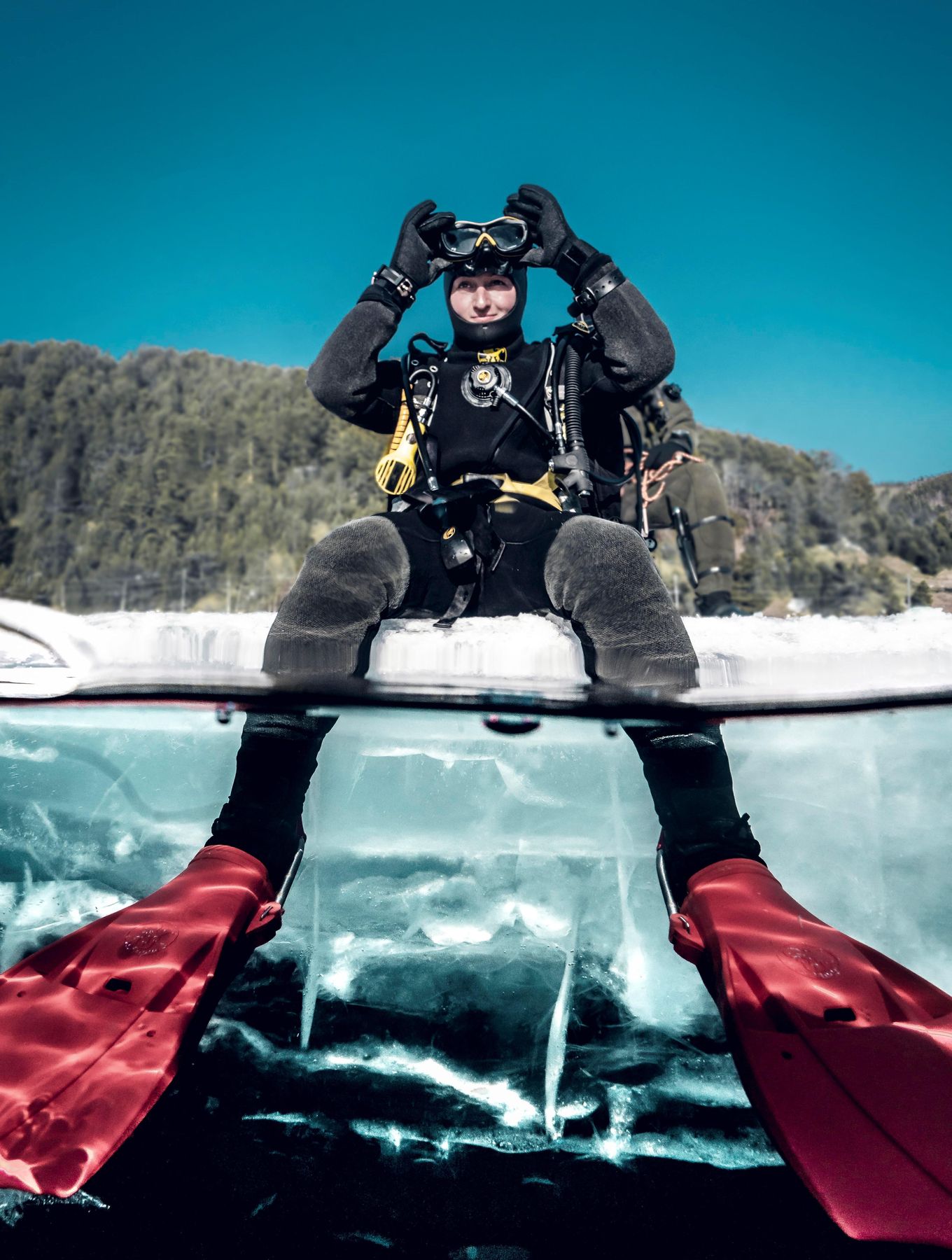
So for our second dive in Bolshiye Koty, we jumped into this mine:
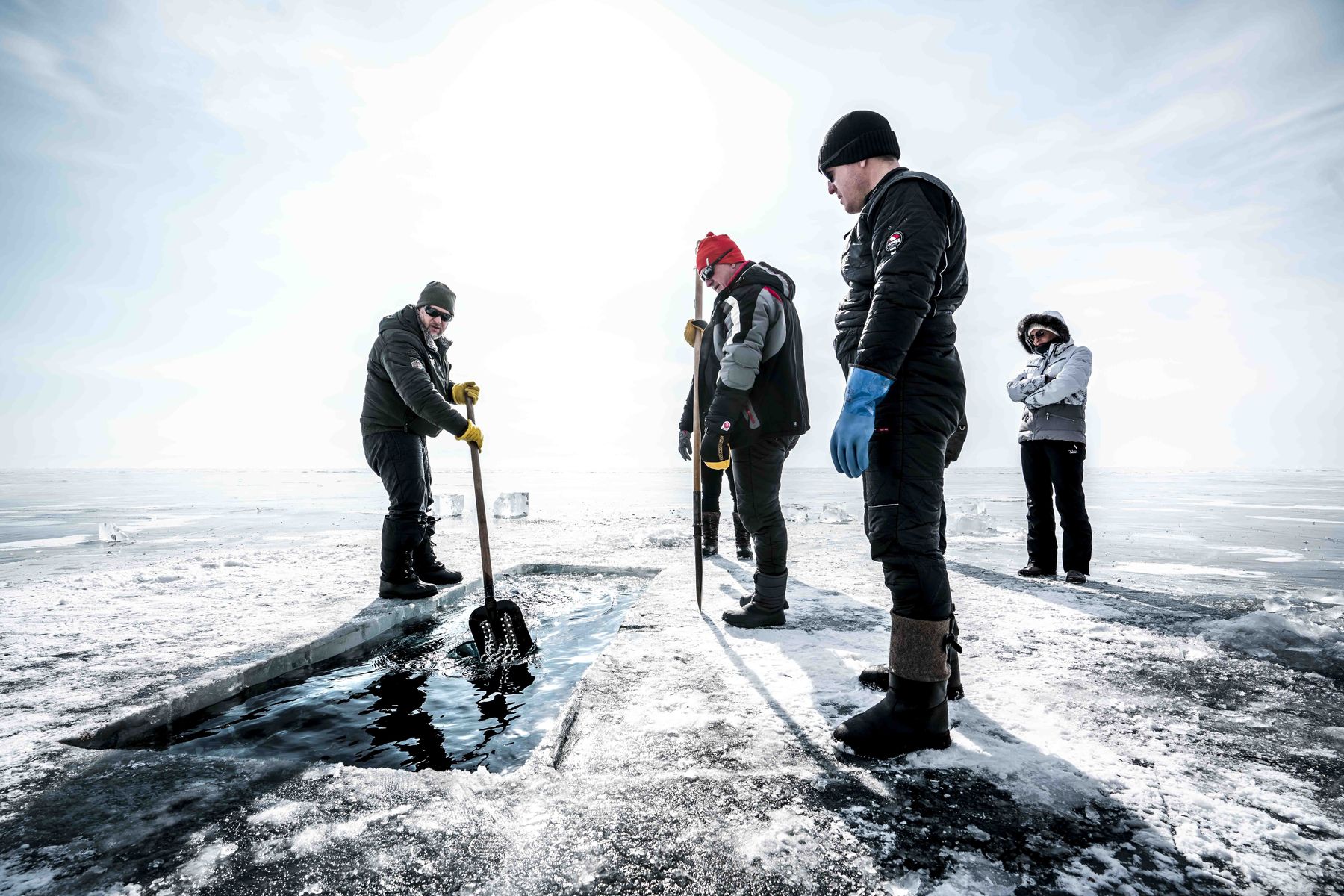
It was a tiny bit frightening to dive into an ice hole in the shape of a grave, in what seemed like the middle of no-where in Siberia… But totally worth it ;)
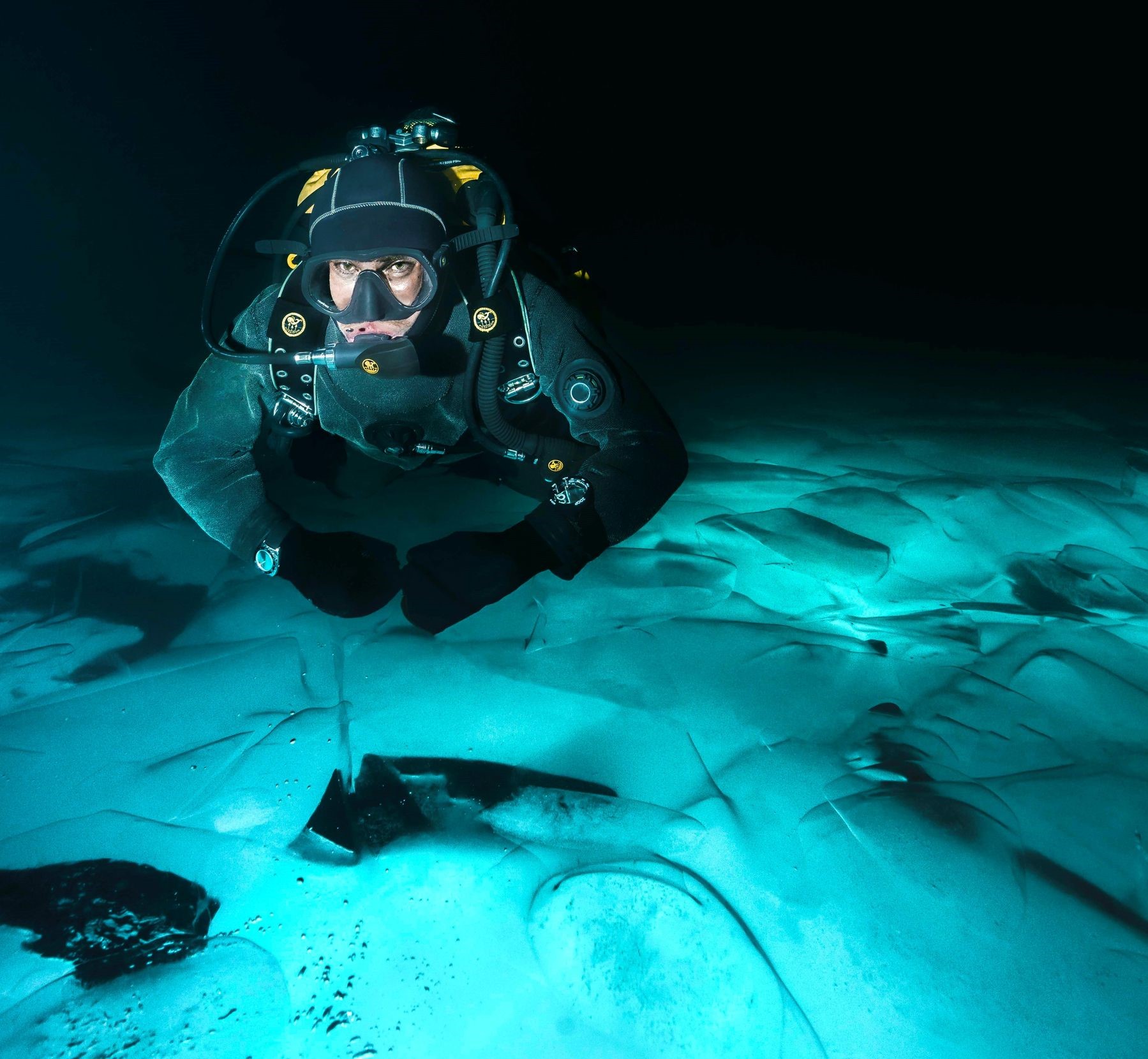
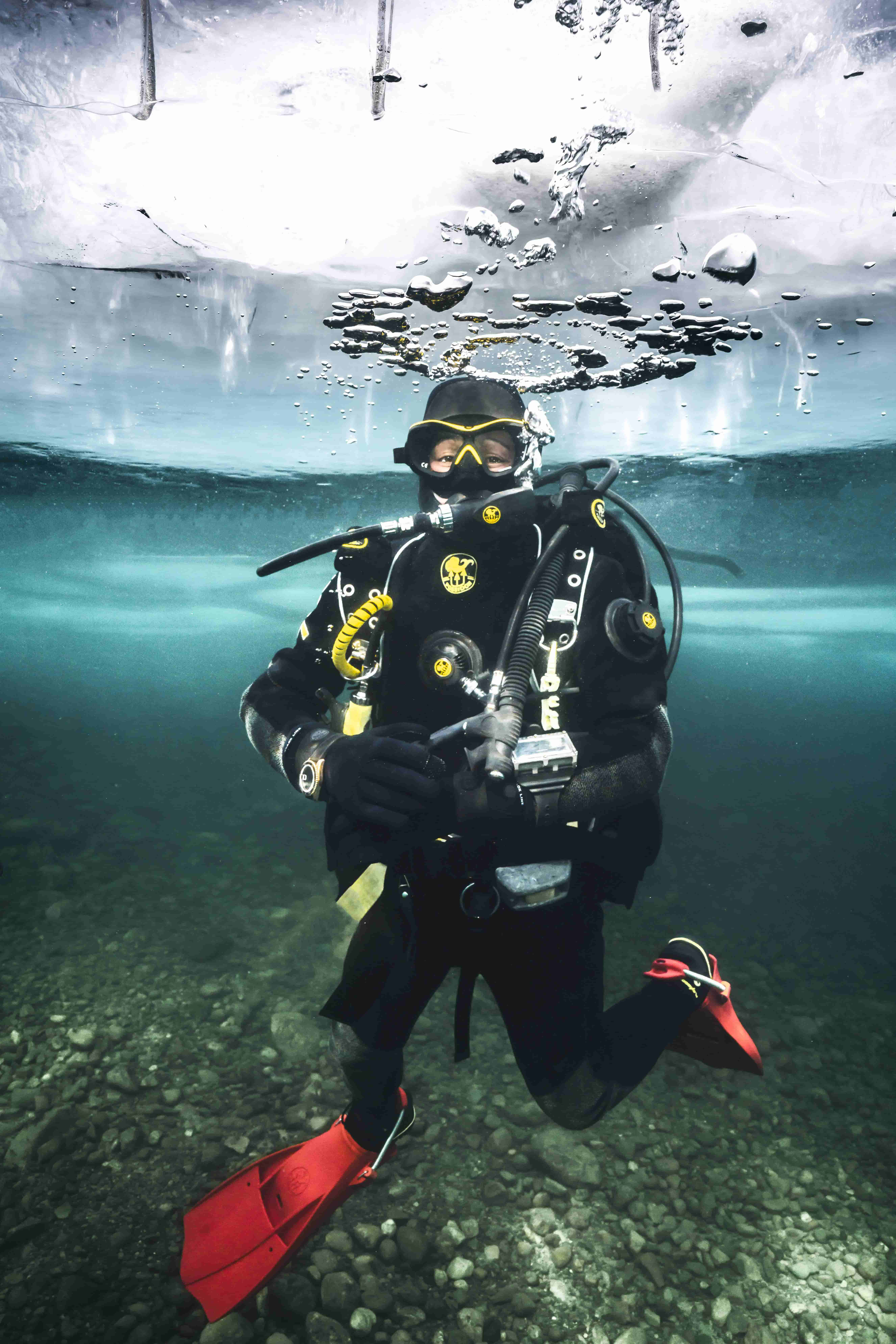
Après-Dive
Between dives, we ate salo (pig fat) on bread to keep us warm, and after the dives, we drove back to our cabin in Listvyanka, unpacked and undressed, then hit the banya ;)
Banya is a Russian sauna where you warm up and unwind after a cold day. In the banya, there is a hot sauna as well as a room temperature area where you can hang out and enjoy some food and drinks.
There is also an interesting sauna ritual that I believe only exists in Russia :) -Hitting yourself or others with a bouquet of dried leafy branches. This is meant to open up your pores, improve blood circulation, and let the heat seep deep into your body. Both Alfie and Nico got a hell of a banya beating from Andrei and his friends :D
Andrei said that both the salo and the banya are an essential part of the diving experience in Russia:
“salo helps you survive, banya helps you revive!”
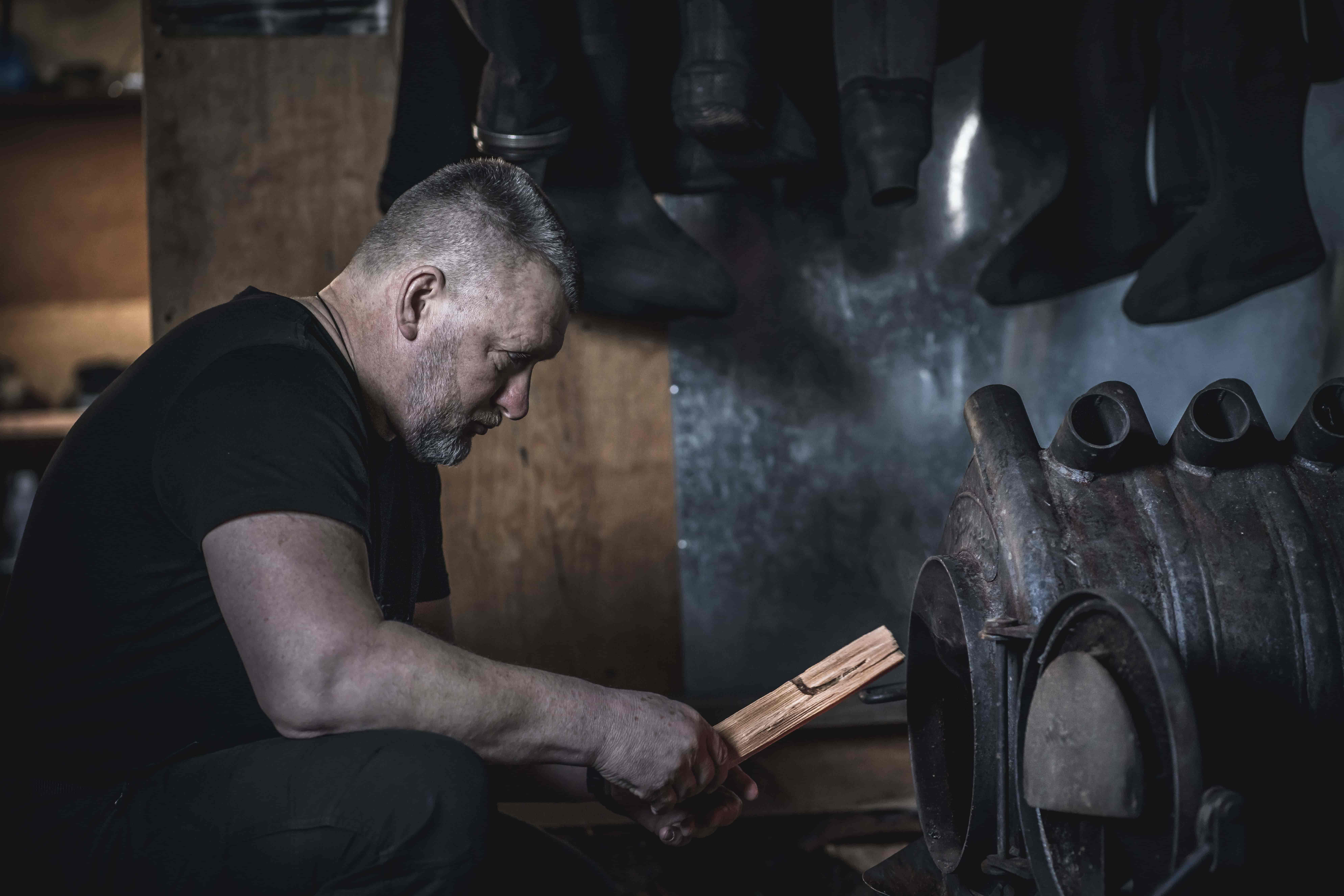
After a few more days of diving and a lot of help from Andrei and his crew, Alfie and Nico got enough underwater footage for the film clips and photos they were sponsored for, but now we needed some land footage.
Olkhon Island
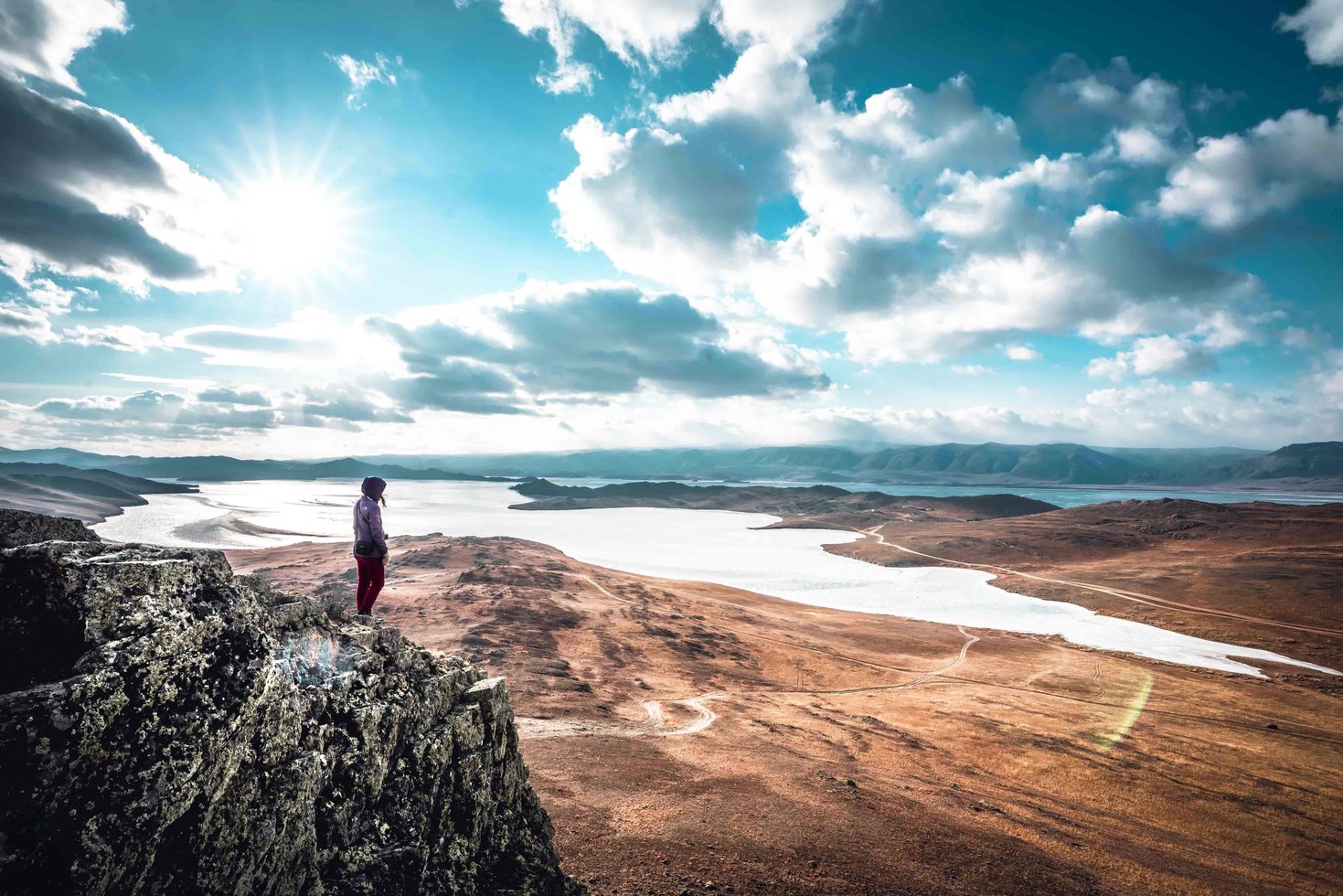
I wanted to bring the guys to the village that I lived in this winter, around Olkhon Island on Lake Baikal. I had spent the winter biking all over the frozen lake in that area so I knew exactly where to film and stay for cheap or free. But there was one dilemma- car rental. We needed a car because we had a lot of gear but none of us had an acceptable license. Nico is German but has a New Zealand License, Alfie is South African but has an Indonesian license, and I am Russian but I have a Hawaiian license.
So rather than renting a car, we made a deal with a friend of mine who had a 4WD and wanted photos of acroyoga :)
– We said that we will pay for his gas, food, and accomodation, and take acroyoga photos with me wherever he wanted, if he would drive us to and around Olkhon Island.
He agreed!
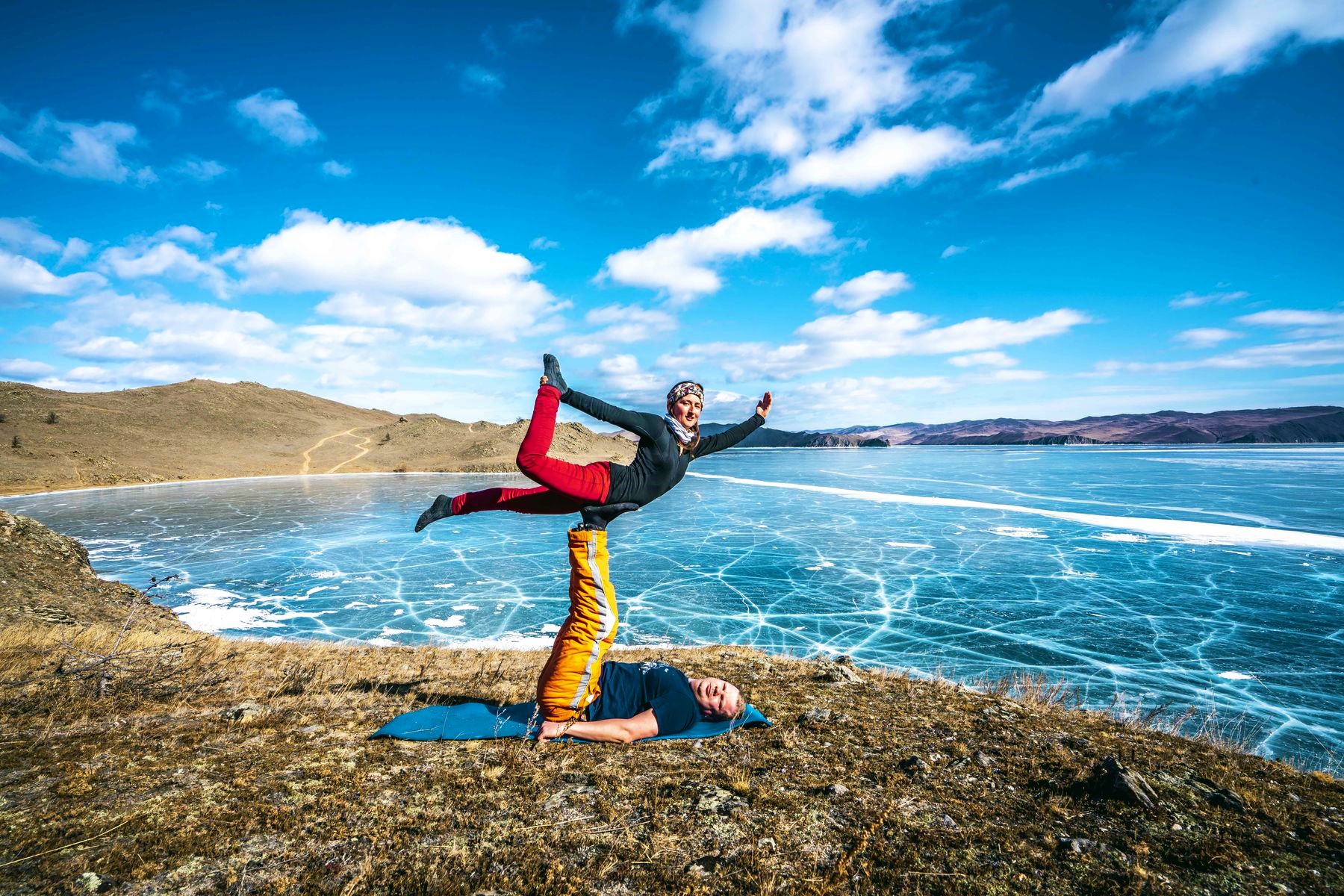
This must have been one of the most random deals I ever made with anybody, but it allowed us to see most of the best sites on the island, get some great video footage for Nico’s film clips, and some pretty cool acroyoga shots while we were at it :D
I suppose this is one benefit to being “Jack (or Jill) of many trades, master of none” :D
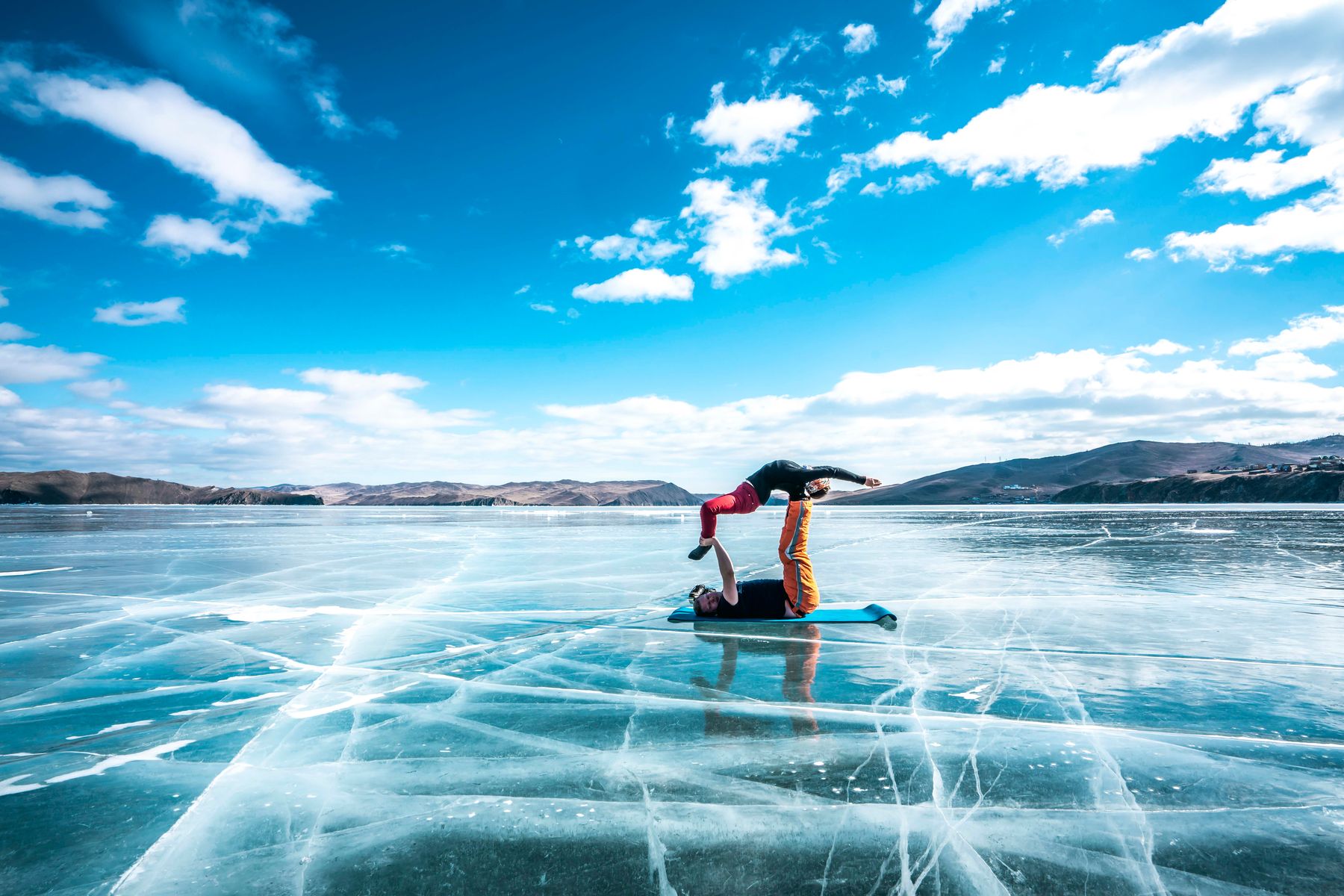
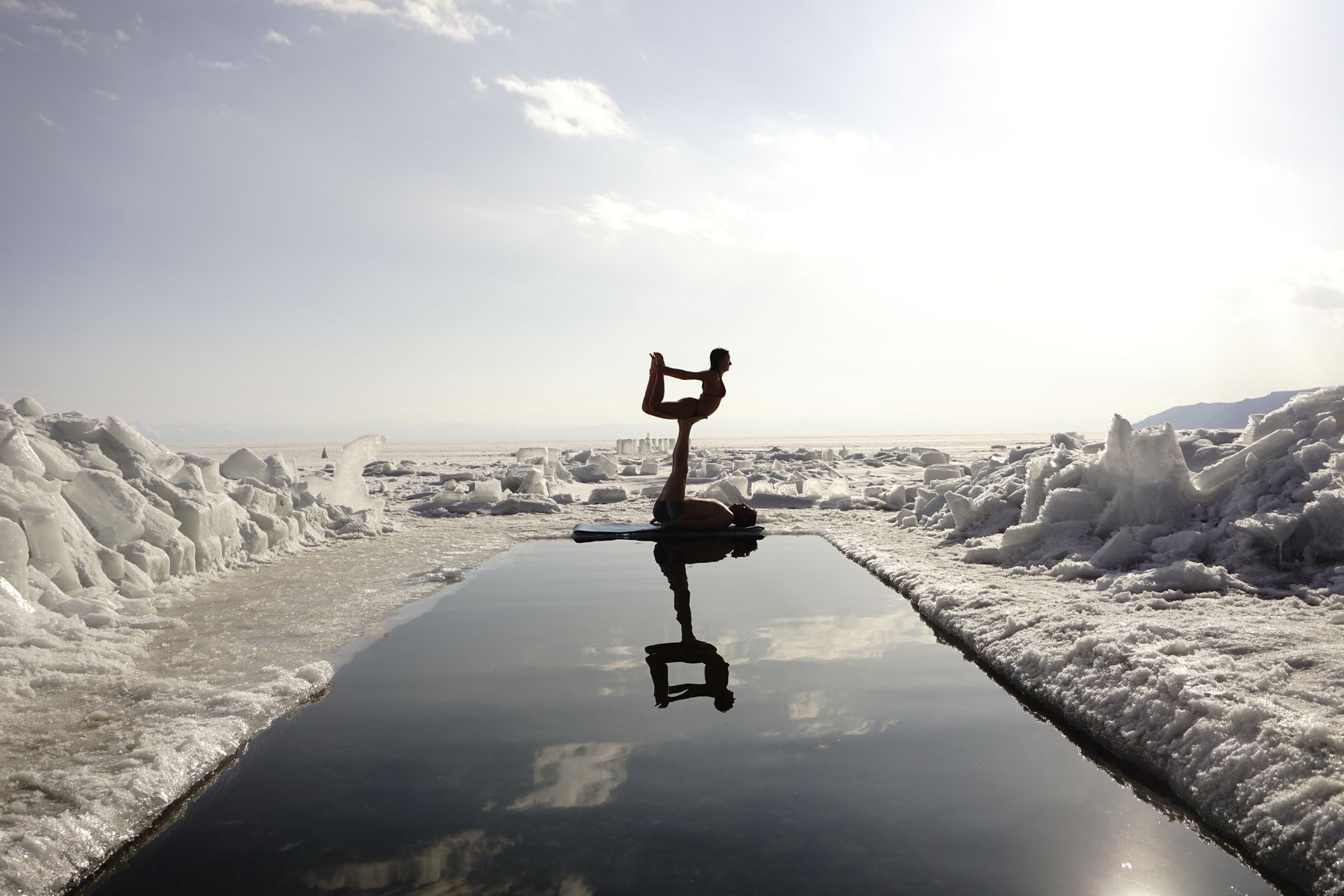
This blog is already very long so I will leave it at that and share the video footage with you once Nico is finished editing.
Expect them to be awesome!
Enormous thank you to Andrei, Olga, Dima, Vanya, Aleksei, and everybody else at DC Sval!
If you’re looking for a good dive center on Lake Baikal, you can contact them here or here.
And of course big thank you to Alfie and Nico for coming out to Siberia and taking these great photos and video clips. And to Anton for all of your help!
Much love and aloha ;)
